The galaxy, one among countless billions, resided within the vast universe. This particular galaxy, spanning a disk of 120,000 light-years and boasting approximately four hundred billion stars, was accompanied by seven smaller satellite galaxies. During the time of the Galactic Empire, five of these satellites were readily accessible. Between five and twenty million sentient species called this galaxy home, with over one hundred quadrillion sentient individuals inhabiting one billion star systems. These beings engaged in constant interaction through avenues such as travel, diplomacy, trade, politics, and even war. Throughout its recorded history, this galaxy experienced the governance of various entities, including the Galactic Republic, the Galactic Empire, the New Republic, the Galactic Federation of Free Alliances, the Fel Empire, Darth Krayt's Galactic Empire and served as the origin of the Jedi and Sith orders, both of which wielded the Force.
This galaxy extended across a distance of 100,000 to 120,000 light-years, equivalent to 37,000 parsecs (where one parsec equals 3.258 light-years), and had existed for an estimated 13 billion years. The luminous disk of the galaxy contained approximately four hundred billion stars, with about a quarter of them having been properly cataloged by the galactic community by the era of the Galactic Empire. The Galactic Center, a supermassive black hole with a mass equivalent to four million suns, served as the rotational center for the luminous disk. Even as late as the Declaration of a New Order, only probe droids had ventured to the black hole at the galaxy's center. The known regions of the galaxy encompassed nearly a billion inhabited star systems, ranging from secret smugglers' outposts to planet-wide ecumenopoleis where virtually no land remained untouched. During the reign of the Galactic Empire, nearly seventy million of these systems possessed sufficient populations to warrant some level of representation.
A bright sphere, known as the Deep Core, formed around the Galactic Center as the galaxy bulged. This region, spanning approximately seven thousand light-years, contained about thirty billion densely packed stars. Near the center, the stars of the Deep Core were separated by distances as small as a hundredth of a light-year, resulting in frequent collisions and the stripping of stellar cores. The majority of stars in the luminous galaxy resided within a disk of spiral arms that rotated around the Deep Core. Galactic civilization recognized four spiral arms: the Bakchou Arm, the Ettarue Arm, the South Arm, and the Tingel Arm. The spiral arms were characterized by concentrations of the brightest supergiant stars, as well as luminous clouds of gas and dust, which contributed to the perceived gaps between the arms, despite the presence of numerous stars in those areas.
Most stars were situated within a thousand light-years above or below the plane of the luminous disk, forming a region two thousand light-years thick, known as the "thin disk". Extending three thousand five hundred light-years on either side of the thin disk was the "thick disk," which contained fewer stars and even fewer systems with planets.
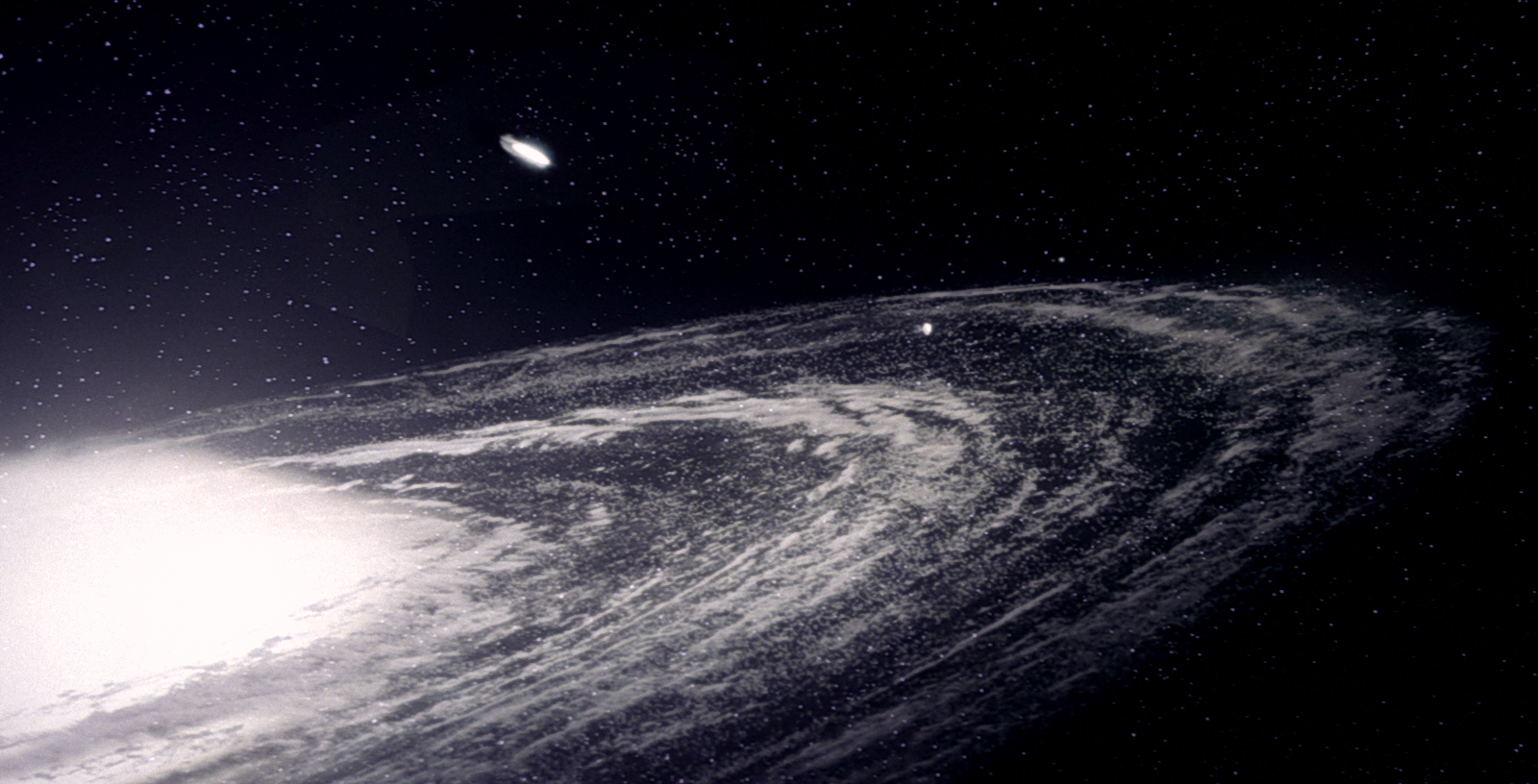
The stellar halo, a vast sphere encompassing the entire galaxy, existed beyond the thick disk. It contained a few billion stars in highly elliptical orbits. Approximately two hundred globular clusters orbited within this region. These clusters typically lacked life and contained hundreds of thousands of extremely old, inhospitable stars within a mere hundred light-years. Despite their inhospitable nature, many globular clusters, such as Cosm's Well, were considered exceptionally beautiful.
Seven dwarf satellite galaxies, some containing as many as twenty billion stars, orbited the primary galaxy. They were ranked according to their distance. The closest, Companion Aurek, also known as the Rishi Maze, was a complex network of stars located high above the galactic plane. Companion Besh, also known as Firefist, was situated approximately 150,000 light-years from the galaxy and had only been explored by probots. The remaining satellite galaxies, Companions Cresh through Grek, were located much further away. Most of these Companions were described as ancient remnants of stars with low metal content and minimal life.
A circumferential hyperspace barrier significantly complicated hyperspace travel beyond the galactic disk, discouraging extra-galactic exploration. This barrier consisted of rapidly spinning whorls and eddies that prevented faster-than-light travel. Some astrophysicists believed that the Celestials, a mysterious ancient race, created this phenomenon. The Intergalactic Void, a vast expanse devoid of stars, separated the galaxy from other galaxies beyond its rim.
While a hyperspace disturbance existed outside the galaxy, hyperspace within the galaxy enabled a vast and diverse civilization. Of the galaxy's 400 billion stars, roughly 180 billion were orbited by a system of planets. The majority, 90%, of the galaxy's stars belonged to the Main Sequence, while the remaining 10% consisted of protostars or stellar remnants such as white dwarfs, neutron stars, and black holes. The larger blue and white stars of the sequence, including O-, B-, and A-type stars like Garnib, Kessa, and Colu, had relatively short lifespans of a few million years, rarely allowing sufficient time for intelligent life to evolve within their systems. The most habitable stars were G- and K-type yellow and orange dwarfs, such as Corell and Yavin, which possessed lifespans of tens of billions of years, providing ample time for life to develop. G- and K-types accounted for 19% of the galaxy's stars, with 75% of them being habitable. However, the most prevalent stars in the galaxy were M-type red dwarfs, comprising 70% of the galaxy's stellar population, but only 1% of them, such as Barab, were habitable. Few red dwarfs were settled, with most being surveyed by probe droids during the early years of the Galactic Republic and subsequently abandoned unless they contained valuable mineable resources.
Considering the heat and light required for an advanced civilization to arise, approximately 7.1 billion stars within the galaxy were truly habitable, resulting in about 3.2 billion habitable star systems. It was estimated that around one billion of these systems were either populated or had been settled by sentient beings.
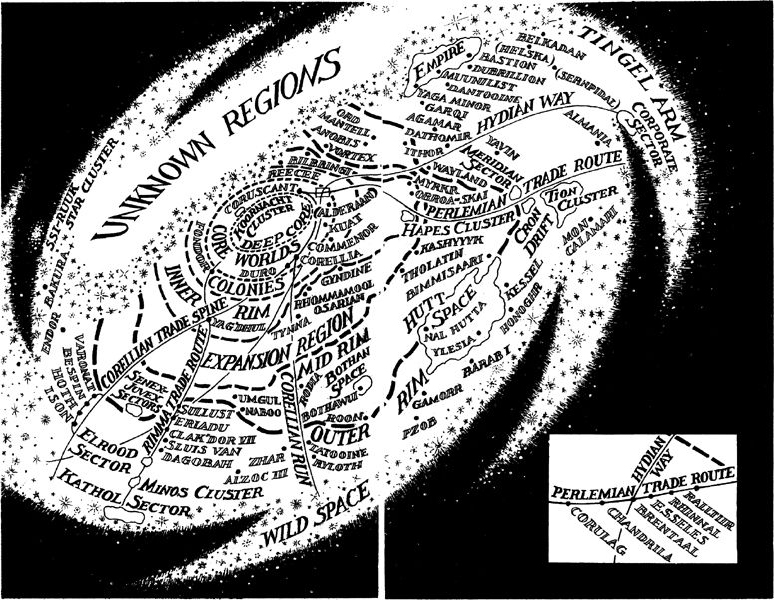
The galaxy was divided into numerous regions, primarily defined by cultural rather than political boundaries, and generally reflecting stages of galactic exploration and settlement. The nine most well-known regions included the Deep Core, the Core Worlds, the Colonies, the Inner Rim, the Expansion Region, the Mid Rim, the Outer Rim Territories, and beyond the galactic frontier, Wild Space, the Unknown Regions and the Galactic Rim. In casual usage, the galaxy was often divided into "the Core" and "the Rim," with the latter encompassing the Expansion Region and areas beyond.
The Deep Core, also referred to as the Core Systems, was situated at the galaxy's heart, spanning seven thousand light-years and containing approximately 30 billion stars. The gravitational forces exerted by the immense number of stars, along with a massive black hole at the center, caused severe warping of local space-time, making hyperspace travel extremely challenging. For millennia, settlement was limited to the fringes of the Deep Core closest to the Core Worlds, within a mathematically defined boundary known as the Horizon. These worlds included Khomm, Thoadeye, Vulpter, and Empress Teta, the dominant planet of the Deep Core. Access to the region's heart was believed to be nearly impossible until Emperor Palpatine discovered several safe hyperlanes. The Deep Core remained a staunch Imperial stronghold, fiercely loyal to the New Order, until nearly twenty years after the Battle of Endor.
Bordering the outer reaches of the Deep Core, the Core Worlds comprised some of the most prestigious, developed, well-known, and densely populated planets in the galaxy. The Galactic Republic, and subsequently all galaxy-wide governments, originated in the Core Worlds and expanded outward. During both the Republic and Empire eras, Coruscant, a prominent Core World, served as the Galactic Capital. The Tetrahedron region within the Core Worlds became the birthplace of the early Republic. Simultaneously, the Perlemian Trade Route and the Corellian Run, both originating from Coruscant, were discovered, creating a region known as the Arrowhead containing the ancient worlds of Alsakan, Anaxes, Basilisk and Ixtlar. Colonization led to the formation of a semi-circular ring extending south to Abregado-rae, often regarded as the pinnacle of the Core Worlds. Subsequent centuries saw the creation of a second ring to the galactic west, although these worlds, derisively referred to as "the Negs" due to their negative-digit galactic coordinates, were viewed with disdain by the rest of the Core. The Core's inherent wealth was bolstered by the farming worlds of the Agricultural Circuit, the semi-independent colonies of the Illodia sector, the Bormea/Darpa Corridor, the manufacturing planets of the Humbarine sector, and the military shipyards of the Kuat sector.
The Colonies, named for being among the first areas colonized beyond the Core, housed many of the galaxy's wealthiest worlds and prided itself on being the galaxy's economic powerhouse. The worlds in this region were typically heavily populated, industrialized, and cultured, serving as the meeting point between Core wealth and Rim raw materials. The Colonies, forming the tip of the Slice, eventually included many of the galaxy's oldest manufacturing worlds, such as Balmorra, Commenor, and Neimoidia. Subsequent colonization efforts led to the development of the shipyards of Loronar, the urbanized worlds of the Pencael system, and the younger worlds of Yabol Opa with its renowned university, the fortress world of Raithal, and the agricultural worlds of the Delle system.
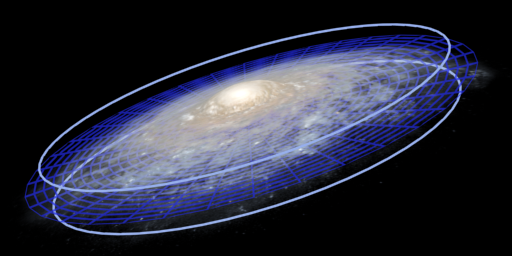
The Inner Rim was a region of the galaxy situated between the Colonies and the Expansion Region. Initially, it was simply referred to as "The Rim," as it was expected to be the farthest extent of the known galaxy for centuries. However, the Expanded Rim (later renamed the Expansion Region) was opened within a hundred years of the Inner Rim's settlement during the Great Manifest Period. Residents of the Inner Rim tended to identify with the Core and looked down upon the "outer galaxy," while simultaneously resenting and envying the greater wealth and history of the Core Worlds. The region had minimal cultural influence and few truly notable planets beyond the ecumenopolis of Denon and the medical worlds of Manaan and Thyferra. As the bridge between the Core and the Rim, the Inner Rim held significant strategic importance, and during both the Clone Wars and the Galactic Civil War, fierce battles were fought over the region.
The Expansion Region originated as an experiment in corporate-controlled worlds, initially known as the Exploitation Region, where powerful corporations heavily exploited the planets for their raw materials, metals, and ores, generating substantial profits. The inhabitants were oppressed as corporations stripped entire stellar systems along the Corellian Run of their resources. The resulting damage was so severe that colonization shifted spinward to the Perlemian Trade Route, causing the conspicuous northern "bulge" in the modern Inner Rim's border. Colonization resumed during the Great Manifest Period, but the Alsakan Conflicts devastated many of the Expansion Region's worlds in the Slice, shifting colonization west of the Corellian Run and creating a stretch of space known as the 77 Sectors that was dominated by Corellians for millennia. This part of the Expansion Region prospered, with the Rimma, Hydia, and Corellian Trade Spine Routes opening up the region and connecting worlds like Tynna, the Gran homeworld of Kinyen, and the trading planets of the Harrin Trade Corridor. The citizens of this region often preferred to disassociate themselves from the rest of the less fortunate Expansion Region, which continued to suffer during the Republic's final millennium. A second, disastrous experiment in corporate control, known as the Outer Expansion Zone, ravaged the region, and the resulting scandal forced the Senate to disband the Expansionist Oligarchy. However, the Slice sectors of the Region fell into economic decline during the final centuries of the Republic. The region's trade routes reflected this decline; while the Core, Colonies, and Inner Rim were characterized by dense networks of tangled hyperlanes, the Expansion Region was poorly served by routes, giving the impression that it had never been settled. Expansion Region worlds continued to produce raw materials and ores, but most natural resources were depleted by the Imperial Period, with Gyndine, Bacrana, and Cyrillia being among the few remaining viable ports.
The Mid Rim, with fewer natural resources and a smaller population compared to neighboring regions, was a territory where residents worked diligently to achieve success. Colonization began concurrently with the settlement of the Expansion Region. While corporations continued to favor exploiting the Expansion Region, religious communes and local political confederations instead took advantage of homesteading incentives and development grants from Coruscant. The Slice in the Mid Rim was colonized gradually over several millennia, following a crosshatching pattern dictated by Coruscant, resulting in an orderly region with ample space for residents to spread out. Corporate exploitation remained concentrated in the Expansion Region, while lawlessness gravitated toward the less-governed Outer Rim Territories, which were opened for colonization simultaneously. Consequently, the Mid Rim developed a successful economy based on low-cost manufacturing and agriculture. Following the blazing of the Hydian Way in 3693 BBY, the northern and southern arcs of the Mid Rim took shape. Historic Republic outposts, such as Malastare, and lost colonies, such as Naboo, found themselves at the heart of new, orderly government-zoned settlement districts, some of which retained their alphanumeric identifications for centuries. Few of the Mid Rim's worlds achieved widespread fame, but notable exceptions included the Wookiee homeworld of Kashyyyk and the Zabrak homeworld of Iridonia, the ocean planet of Glee Anselm, the Order of the Sacred Circle's retreat of Monastery, and Ansion, a nexus of several hyperlanes connected by the Keitumite Mutual Military Treaty.
The Outer Rim Territories comprised the largest region of the galaxy and the last extensively settled area before Wild Space and the Unknown Regions. It was characterized by obscure worlds and rugged, primitive frontier planets. Historically, government control was weakest in the Outer Rim Territories due to its distance from the Core, making it a traditional refuge for dissidents, pilgrims, and freedom-seekers, but also a region plagued by lawlessness, oppression, and violence. Consequently, the worlds of the Outer Rim were immensely diverse. Eriadu was a prosperous, industrialized megalopolis, and Entralla was a vibrant, Human-dominated spaceport world, while Terminus and Aduba-3 were criminal-run shadowports, and Tatooine was a Hutt-controlled trade depot. The Outer Rim also featured sparsely inhabited worlds like Dagobah, Hoth, Tund, and Muskree. Worlds located closer to major super-hyperroutes tended to be more civilized, while those far from these trade links were often dominated by the Hutts. Large-scale settlement of the Outer Rim began after 5500 BBY, when colonists capitalized on the new trade routes of the Hydian, the Rimma, and the Corellian Trade Spine. Settlement in the southern quadrant progressed rapidly, but expansion in the northern quadrant was hindered by the Great Galactic War and the horrors of the Kanz Disorders. Contrary to the galaxy's usual pattern, colonization was slowest in the Slice, which was dominated by Hutt Space. Republic authority in the region effectively collapsed during the New Sith Wars, and arguably never fully recovered, with the Hutts filling the power vacuum and piracy, slavery, and anarchy prevailing. In 124 BBY, the Senate declared the entire region a Free Trade Zone in an attempt to stimulate economic development, but this was exploited by the Trade Federation. The Senate's re-imposition of taxation in 33 BBY triggered the Invasion of Naboo and the Separatist Crisis. The Galactic Empire oppressed much of the Outer Rim, leading to increased sympathy for the Alliance to Restore the Republic in the region. However, both the New Republic and the Galactic Alliance failed to establish central control in the area, leaving the Outer Rim largely unchanged for centuries.
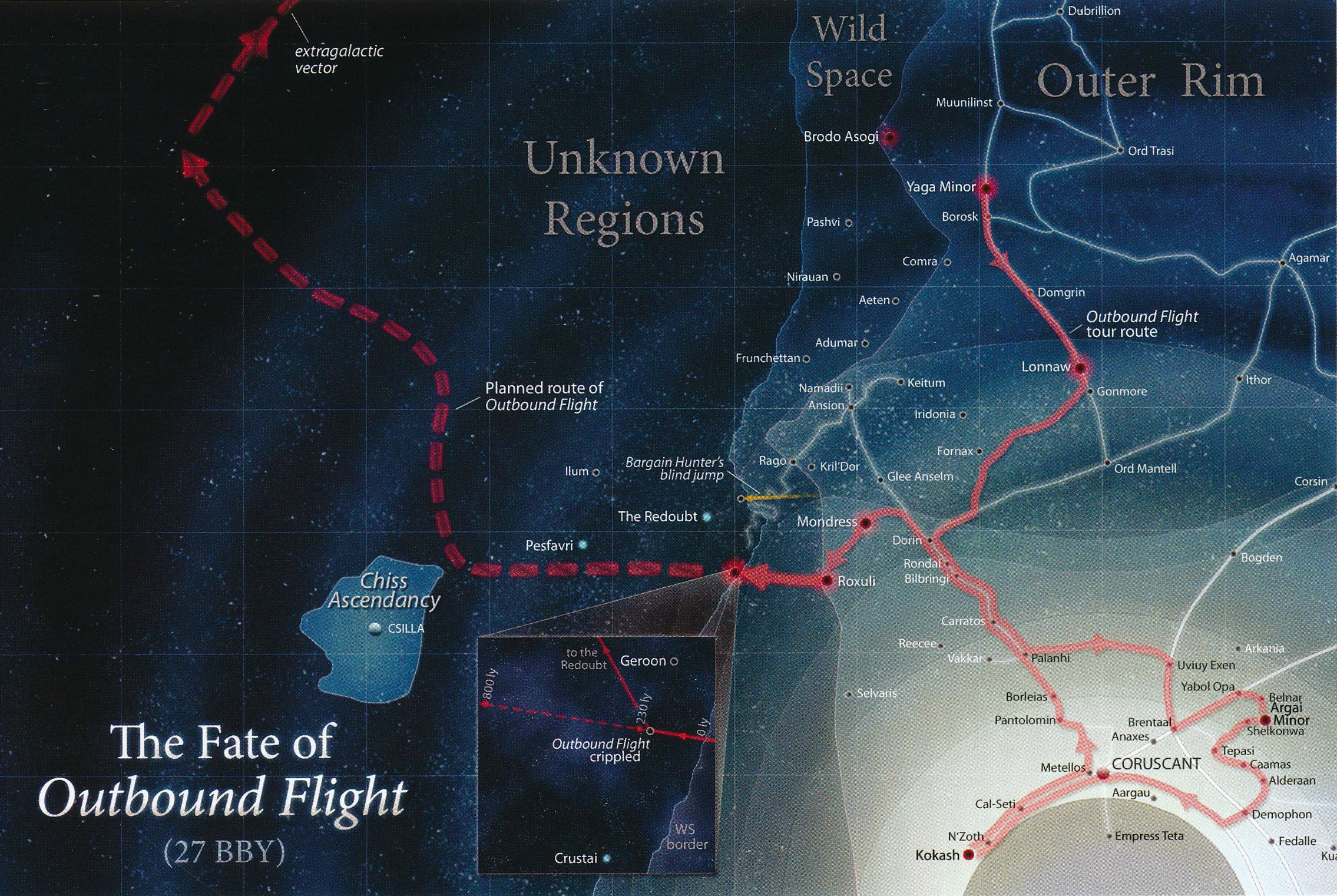
The areas beyond the direct surveys of the Republic or Imperial scouts were called "Unknown Regions". This term was most often used for the less explored parts of the galaxy's western disk, a region extending roughly from Bakura to the Imperial Remnant. However, it also included the galaxy's halo of gas, dust, and stars, as well as the satellite galaxies. The aggregate of this territory was nearly three times the size of settled space, though some calculations placed only 15% of the galactic disk's total stellar mass within the Unknown Regions. The lack of western equivalents to the Perlemian Trade Route and the Corellian Run contributed to the Unknown Regions' existence within the galaxy, as Republic scouts initially focused on easier-to-reach areas like the Slice. It was later discovered that a tangle of hyperspace disturbances barred the westward path, effectively dividing the galaxy and forming the midline of the galactic barrier that encircled it. Despite this barrier, the Unknown Regions were not entirely inaccessible, with spacer tales recounting strange ships visiting Outer Rim ports like Terminus, hyperdrive malfunctions sending ships across the divide, and ancient alien paths providing access.
One of the earliest official attempts to navigate the Unknown Regions was the doomed Outbound Flight Project, while Grand Admiral Thrawn of the Galactic Empire spent years mapping parts of the region. The Chiss were the dominant species of the Unknown Regions, but the area remained a lawless and untamed area compared to known space, where the early Republic had subdued or eliminated most amoral or expansionist species. Other powerful species in the region included the slaver empire of the Vagaari, the illusion-weaving Crokes, the religiously fanatical Ssi-ruuk, and the blind berserkers of the Leech Legion. Beyond the disk, in the satellite galaxy of Companion Besh, lived the Nagai and their oppressors, the Tofs. The Nagai invaded known space in 4 ABY, pursued by the Tofs, and allied with the Alliance of Free Planets to defeat their oppressors and liberate Firefist.
Following the Yuuzhan Vong War, the normalization of relations with the Chiss Ascendancy led to the establishment of stable hyperroutes into the Unknown Regions through areas like the Utegetu Nebula, including the Rago Run. By 44 ABY, the term "Unknown Regions" was largely inaccurate when referring to the galactic disk. However, the galactic halo and satellite galaxies remained largely unexplored and mysterious.
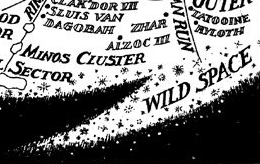
Wild Space, not a formal designation, represented the galactic frontier, encompassing unsettled regions and areas with minimal colonization or development. During the Imperial Period, Wild Space typically referred to the outer reaches of the galaxy's eastern disk, along with the narrow strip separating the civilized galaxy from the Unknown Regions. One of Emperor Palpatine's final actions was to facilitate increased exploration of this region. Wild Space differed from the Unknown Regions in that it had been partially explored, with findings recorded, while the Unknown Regions remained shrouded in mystery. The worlds of Wild Space generally disregarded the central government, were mostly peaceful, but often served as havens for criminals.
The Galactic Rim was situated at the galaxy's edge, distant from most civilization, and largely unknown. The Galactic Rim exhibited a decrease in luminosity as the stars thinned out. Nevertheless, the Galactic Republic was aware that the Yuuzhan Vong had established a foothold at the galaxy's edge. The Galactic Empire possessed a large shipyard there, which the Dark Empire later utilized.
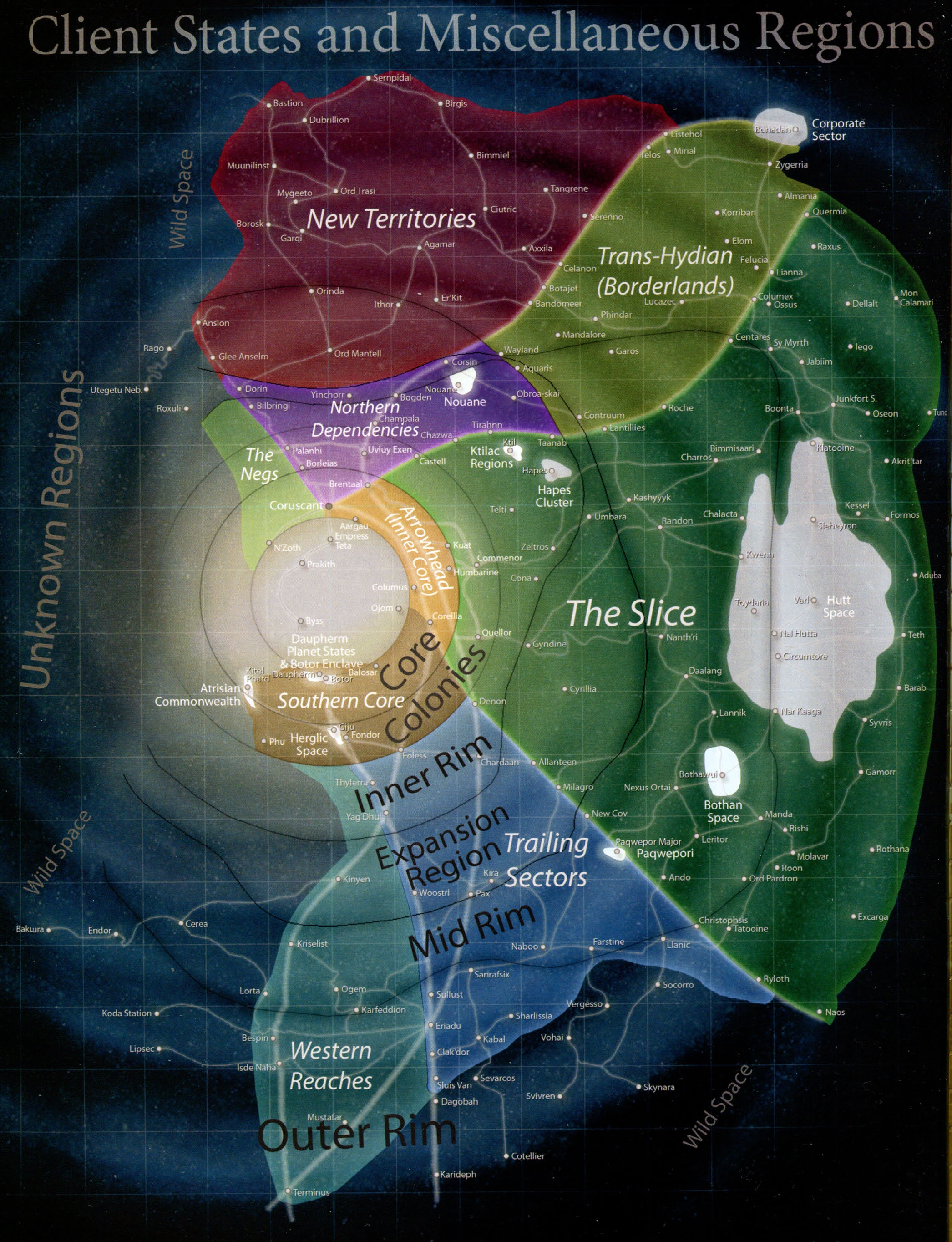
The galaxy's ten major regions did not fully capture its political and cultural complexities. Between the Core and the Outer Rim existed numerous groupings and prefectures, some with their own regional governments, others united only by shared cultural stereotypes. The largest of these was the Slice, a vast area between the Perlemian and Corellian Run, generally considered the heart of galactic civilization and commerce. At its apex was the Arrowhead, encompassing the Core Worlds portion of the Slice, with Coruscant at its point. The Arrowhead's other two points traditionally rested on Vento on the Perlemian and Corellia itself on the Run. The Arrowhead, home to the elite of the Core Worlds, evolved from the ancient pre-Republic Tetrahedron, the birthplace of galactic civilization. Sometimes referred to as the Inner Core, the Arrowhead included Ixtlar, Alsakan, Grizmallt, and Anaxes, with prestige increasing closer to Coruscant.
Colonists from the Arrowhead settled the Slice, venturing into what became the Colonies and beyond. The worlds along the Perlemian and Corellian Run were settled for millennia, with colonization gradually expanding to connect the Slice. The Core, Colonies, and Inner Rim sections of the Slice were densely populated and crisscrossed by numerous hyperlanes and praediums. The Expansion Region was heavily colonized near the Corellian Run (dominated by Corellian interests) but more sparsely settled south of the Perlemian, a consequence of the long-lasting Alsakan Conflicts. The Slice's prominence had begun to wane by the time colonists moved beyond the Expansion Region in the central Slice. The Mid Rim reaches were well-surveyed but sparsely settled, while the Hutts controlled the Outer Rim precincts, even beyond Hutt Space. Although new industries and businesses had largely migrated beyond the Slice by the time of the Clone Wars, the region remained the perceived center of galactic civilization, a distinction its inhabitants cherished.
The Southern Core was populated from the Arrowhead and expanded through interactions with various advanced ancient civilizations, including the Devaronians, the Herglics, and the Atrisian Commonwealth. This resulted in a diverse region that defied easy categorization. The western quadrant of the Core Worlds long resisted exploration due to the absence of super-hyperroutes, restricting progress along hyperlanes like the Metellos Trade Route to short jumps. Worlds settled along this western frontier received a negative first digit in their galactic coordinates due to their location west of Coruscant, earning them the moniker "the Negs," and relegating areas like the Farlax sector to perpetual second-class status within the Core.
The Northern Dependencies, a region long settled north of Coruscant, generally looked outward towards Nouane, the worlds of the Hydian Way, or the New Territories beyond. Many of the galaxy's greatest traders, explorers, and entrepreneurs originated from the Northern Dependencies, and the region included some of the galaxy's oldest worlds, rarely concerning itself with Core World politics. To its northeast, the region north of the Perlemian Trade Route was the Trans-Hydian, an area with scattered worlds with ancient histories, such as Mandalore or the planets of the Sith Worlds and the Tion Cluster, but largely economically sidelined until late in galactic history. Economic development shifted from the Slice to the Trailing Sectors further south, and then followed the Hydian Way into the New Territories. For millennia, the threat of the Mandalorians, rumors of the ancient Sith, and geographic anomalies like the vast Radama Void favored more profitable ventures elsewhere. The Trans-Hydian's name came from traders from Ord Mantell and Celanon, who risked Mandalorian raids to forge new trade routes like the Listehol Run, the Shaltin Tunnels, and the Gordian Reach to connect the Hydian and Perlemian routes. After the Battle of Endor, the region's loyalties were divided between the Empire and the New Republic, earning it the name of the Borderland Regions.
The Trailing Sectors were settled during the Alsakan Conflicts, which devastated many colonies in the Slice, leading to enslavement, ruin or depopulation, and prompting colonization west of the Corellian Run. Here, intrepid traders had long engaged in commerce with the Herglics, Givin, and Tynnans, and the Expansion Region's Trailing Sectors soon surpassed the Slice sectors, spurring expansion into the Mid Rim. The rise of the Rimma Trade Route in 5500 BBY and the Hydian Way two thousand years later further accelerated this long boom, uniting the region for traders from across the galaxy. Inhabitants of the Trailing Sectors tended to see their region as building upon the successes and traditions of the Slice while avoiding its mistakes, valuing entrepreneurship and hard work.
The Western Reaches developed around the Corellian Trade Spine and the Hydian Way, with settlement flowing in from the Southern Core and the Trailing Sectors, inheriting those regions' diversity and independence. Explorers and settlers continued to expand the region as late as the period of the New Republic, pushing further west into the Unknown Regions. The Reaches' independence and distance from Coruscant historically made them a hotbed of rebellion, serving as refuge for the last holdouts of the Confederacy of Independent Systems after the Clone Wars. The Galactic Empire launched a massive campaign to pacify the Western Reaches, but the area remained a sanctuary for the Alliance to Restore the Republic throughout the Galactic Civil War and was the site of numerous Imperial atrocities.
The New Territories lay beyond the Northern Dependencies in a region that had developed slowly compared to much of the galaxy. Worlds like Ithor, Ord Mantell, and Iridonia were well-known, but they existed as isolated outposts. Large-scale efforts to promote settlement in the northern quadrant repeatedly failed, resulting in disasters like the Kanz Disorders and the Outer Expansion Zone. The region was finally properly settled in the final years of the Republic, with the D'Asta merchant family of Serenno establishing markets along the Braxant Run, while the Nalroni Merchant Council expanded along the Celanon Spur. These economic successes encouraged Coruscant to invest heavily in the region, soon dubbed the New Territories, and between Republic spending on programs like the Planetary Pioneers and the influence of the D'Asta family, the region was strongly Loyalist during the Clone Wars and the Galactic Civil War. The New Territories formed the core of many Imperial successor states after the Battle of Endor, and it became the contested frontier between the New Republic and the Imperial Remnant. The New Territories suffered greatly during the Yuuzhan Vong War and struggled to recover afterward.
Approximately thirteen billion years before the Battle of Yavin, the galaxy was formed when a vast cloud of gas and dust collapsed under its own gravity, coalescing into a rotating disk. Over billions of years, stars and planets began to form. By 5,000,000,000 BBY, life began to emerge, with some of the earliest non-sentient organisms developing on Goroth Prime.
Around 2,000,000 BBY, many of the galaxy's most well-known species were evolving: the Wookiees originated on Kashyyyk as tree-dwelling creatures. The Oracle of Pelgrin, possibly the galaxy's oldest artifact, is believed to date back to this time. By 200,000 BBY, the Zhell, ancestors of the Humans, had developed intelligence and were engaged in war with the Taungs for control of their shared homeworld of Notron, later known as Coruscant.
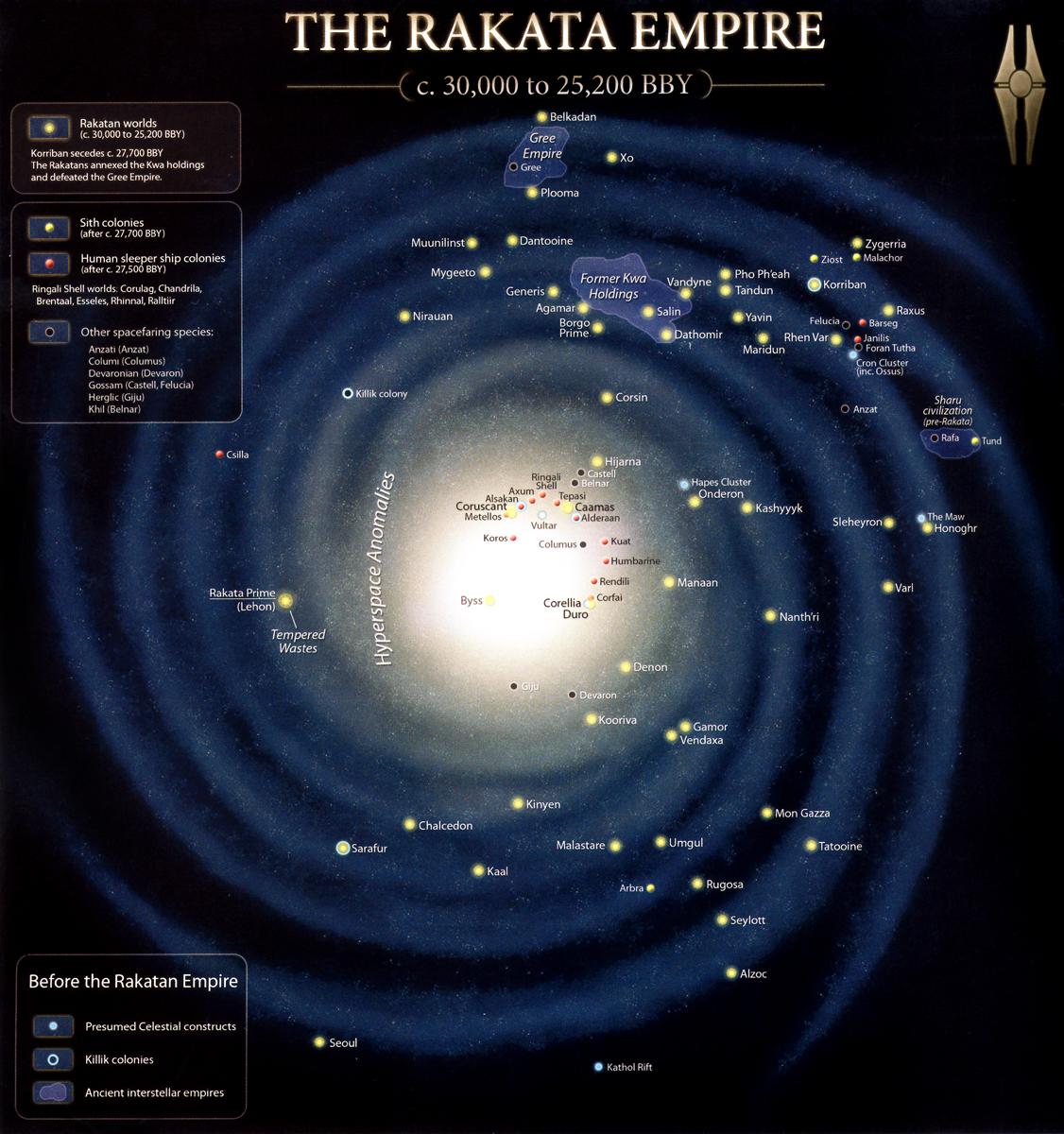
By 100,000 BBY, the galaxy was dominated by a mysterious race called the Celestials. Also known as the Architects, this incredibly powerful race was thought to be able to manipulate and move stars. Surviving Celestial technology, such as Centerpoint Station and the Cosmic Turbine, could manipulate gravity on a massive scale using repulsor pulses, tractor beams, and hyperspace wormholes. Using this technology, the Celestials were believed to have constructed the Corellian system, the Vultar system, and 15 other star systems, as well as the Hapes Cluster, the Kathol Rift, and the Maw black hole cluster. Pre-Republic scholars suspected that the Celestials were also responsible for the circumferential hyperspace barrier, possibly as a defense against external threats. They were also believed to have created the chain of hyperspace anomalies west of the Core, which bisected the galaxy and prevented travel into the Unknown Regions. It is speculated that the Celestials crafted these hyperspace anomalies to contain the Rakata.
Around this time, several other spacefaring races became clients of the Celestials. The insectoid Killiks of Alderaan were exploited as laborers and dispersed throughout the galaxy, until around 30,000 BBY when they disappeared into the western regions of the galaxy and the Unknown Regions, presumably relocated by the Celestials. The Kwa and the Gree utilized structures known as Infinity Gates and hypergates, respectively, to travel between planets, leading to territorial conflicts. Other species fled to escape the Celestials: the Sharu of the Rafa system in the far east of the galaxy experienced a brief period of expansion, spreading their distinctive plastic pyramid cities as far into the Core as Aargau, but this may have attracted the attention of the Celestials, causing the Sharu to bury their cities and seek refuge in primitivism to evade them. Similarly, the Columi of Columus surveyed both Humans and Duros in the Core and were unimpressed by their findings, but also retreated to their homeworld, possibly to avoid retribution from the Celestials.
A cosmic war occurred at some point in the galaxy's ancient past. Around 35,000 BBY, the reign of the Celestials was overthrown when the Rakata slave race revolted. By stealing technology from the Kwa, they waged war against the other servant races, and broke through the barrier surrounding the Unknown Regions into the galaxy proper and waged a war of extermination upon the Celestials. The final fate of the Celestials remains unclear. They may have been trapped within the galaxy by their own barrier and destroyed during the Rakatan revolt, or they may have escaped through the barrier. By 30,000 BBY, the Celestials had vanished, and the Rakatan Infinite Empire rose to prominence.
The Rakata expanded from their homeworld of Lehon in the Tempered Wastes of the Unknown Regions, using hyperdrives that channeled the power of the Force to navigate to worlds with strong Force signatures. The Infinite Empire occupied scattered systems across the galaxy, but vast areas between these holdings remained untouched, allowing smaller interstellar confederations to prosper. The Devaronians and the Gossam experimented with the tumble hyperdrive, and while worlds like Coruscant, Corellia, and Duro were under Rakatan occupation, Humans, Duros, Selonians, and Drall were able to study the principles of the Rakatan hyperdrive. The Rakata proved to be brutal masters, subjecting entire populations to slavery. After nearly five thousand years of dominance, the Rakatan Empire collapsed due to a devastating plague that robbed the Rakata of their ability to use the Force. A colonial slave revolt completed the empire's destruction by 25,200 BBY.
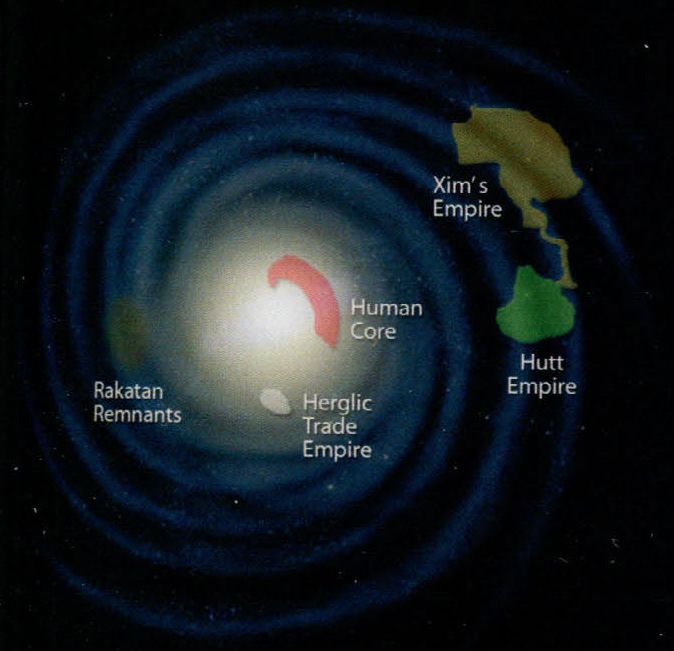
The decline of the Infinite Empire coincided with the reverse-engineering and refinement of Rakatan hyperdrive technology by other species in the galaxy. Developing technological replacements for its Force-based components, various species ventured from their homeworlds, initially with slower-than-light sleeper ship colonies, followed by the development of the hyperspace cannon. Through this reuse of Rakatan technology, several civilizations emerged: the Humans and Duros dominated the Core, while the cetacean Herglics established their own trade empire to the south. On the Rim, Human sleeper ship colonies formed the Tionese civilization, which was unified into an empire by Xim the Despot, before engaging in conflict with the empire of the Hutts.
This period also marked the beginning of the Jedi Order on Tython, with its studies of the Force, and the religious rivalry between understandings of the light and dark sides of the Force. Conflict between the Jedi and the Dark Jedi would recur throughout galactic history, a cycle that persisted beyond the Yuuzhan Vong War.
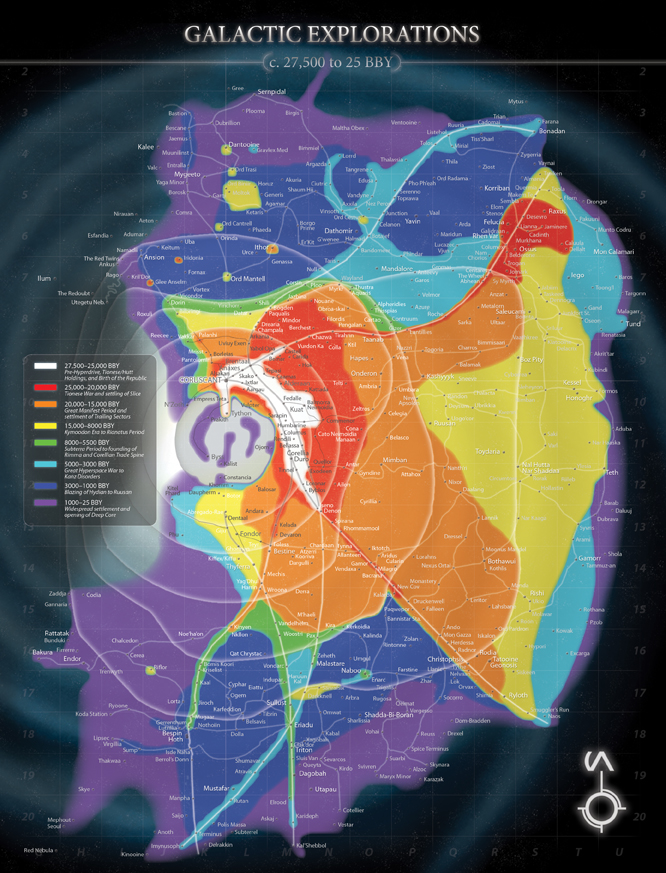
In the year 25,000 BBY, subsequent to the Unification Wars, the diverse states residing in the Core region convened on Coruscant. Here, they formalized the Galactic Constitution, thereby giving rise to a civilization governed by a shared legal framework, language, and monetary system, and heralding the dawn of the Galactic Republic. This Republic served to unify the predominantly Human Core Worlds, with the Core Founders encompassing influential political entities such as Coruscant, Alsakan, Corellia, Duro, Kuat, and Alderaan. It also included military powers like the Azure Imperium of Axum and Anaxes, alongside commercial hubs like Esseles, Rendili, Tepasi, Brentaal IV, and Humbarine. Furthermore, it incorporated worlds of significance in medicine, diplomacy, and philosophy, such as Chandrila, Caamas, Rhinnal, and Shawken.
The era known as the Expansionist Era was concurrent with the establishment of the Republic. During this period, the systematic mapping and colonization of a significant portion of the galaxy's spiral commenced. Scouts venturing eastward from Coruscant navigated two primary trade routes: the Perlemian Trade Route and the Corellian Run. These routes delineated the boundaries of a substantial spatial sector referred to as "the Slice." At the termination of the Corellian Run was Kalarba, a trading center overseen by the merchants of Paqwepori, while the Perlemian led to the trading planets of Tirahnn, Nouane, and Roche. The absence of comparable routes to the galactic west resulted in a considerable portion of that quadrant remaining largely unexplored and shrouded in mystery, ultimately becoming known as the Unknown Regions. This expansion led to the Republic entering into conflict with the Human civilizations inhabiting the Tion Cluster. Following its triumph in 24,000 BBY, the Republic's territory expanded beyond its initial capacity for governance, as numerous systems sought protection from the depredations of the Hutts.

The Great Manifest Period initiated around 20,000 BBY, marked by the extensive colonization of the Slice, with the dense network of systems at its apex becoming known as the Arrowhead. This area was predominantly controlled by Coruscant, while Corellia held sway over the settlements along the Corellian Run. The First Alsakan Conflict, erupting in 17,000 BBY due to rivalry between Coruscant and Alsakan regarding policies on the Perlemian, marked the beginning of the Indecta Era. Although peace was eventually negotiated, the Alsakan Conflicts persisted in a reduced form for approximately 14,000 years. Furthermore, the initial five Alsakan Conflicts served to discourage settlement along the Perlemian, directing colonists towards the Corellian Hegemony in the Trailing Sectors along the Corellian Run, and the burgeoning Corellian Trade Spine.
The Kymoodon Era, commencing in 15,000 BBY, ushered in another wave of colonization comparable to the Great Manifest Period. Advancements in hyperdrive technology enabled the emergence of disparate pockets of colonization in the largely uncharted northern and southern quadrants. Additionally, the Herglics joined the Republic, initiating a surge in development around the Hidakai Pool, which would eventually become the Rimma Trade Route. However, this era also sowed the seeds for future discord, as the Republic's borders increasingly bordered those of Hutt Space, leaving isolated colonies vulnerable to raids by Hutt slavers. Widespread resentment towards the Hutts in the Rim was exploited by Contispex I and the Humanocentric Pius Dea religious sect to initiate a series of Crusades against the Hutts in 12,000 BBY. The millennia-spanning Pius Dea Era witnessed the conquest, persecution, or extermination of numerous non-Human species until the Contispex dynasty was overthrown by the Jedi Order, fostering extreme resentment among the species residing in the Rim. The subsequent Ductavis Era and Rianitus Period, spanning from 11,000 to 8000 BBY, were characterized by retrenchment and reconstruction following the Crusades.
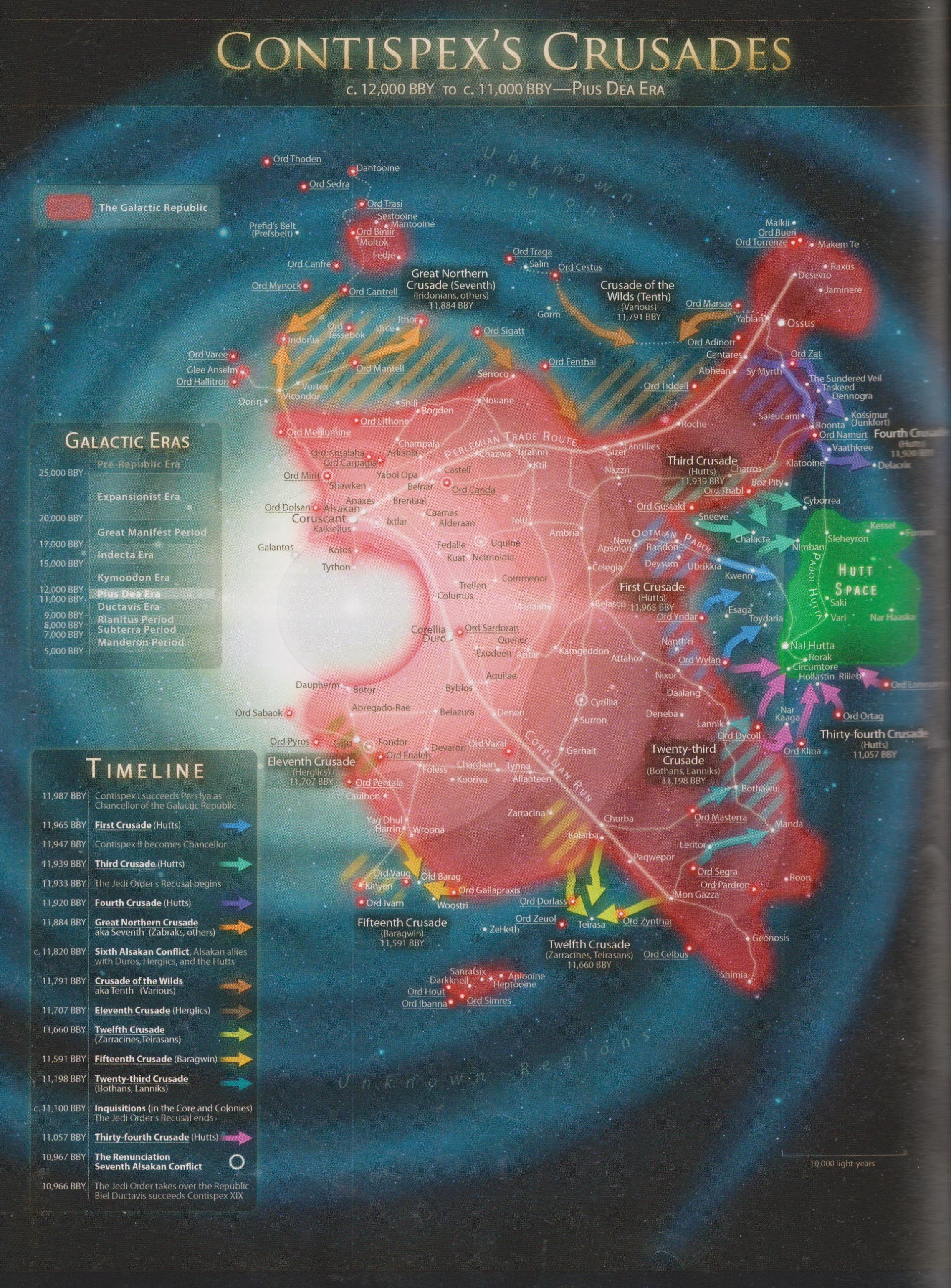
The Subterra Period, spanning from 8000 to 7000 BBY, saw the renewed mapping of the galactic southern quadrant, with colonies such as Malastare serving as anchors for the intricate network of praediums that connected the region. Around this time, scouts also ventured into the Rishi Maze. However, the absence of a super-hyperroute into the southern quadrant, coupled with the general inaccessibility of the new colonies, fostered lawlessness in the Rim and limited Coruscant's authority. This is believed to have contributed to the Second Great Schism within the Jedi Order in 7003 BBY, triggering a galaxy-wide insurrection of Dark Jedi known as the Hundred-Year Darkness. In the aftermath of the conflict, the defeated Dark Jedi were banished beyond the Rim into the unexplored space north of the Perlemian. There, the Exiles established settlements on the worlds of Korriban and Ziost within the Stygian Caldera, where they subjugated the indigenous Sith species and established an empire.
During the Manderon Period, in 5500 BBY, the Corellian Trade Spine and the Rimma Trade Route were formally established after the Herglics, Givin, and Corellians interconnected hundreds of pre-existing praediums, thereby enhancing access to the southern quadrant. In 5000 BBY, the Republic rediscovered the Sith Empire, initiating the Great Hyperspace War when the Sith Lord Naga Sadow attempted to conquer the Republic. Although the Sith were defeated and once again exiled, this marked the beginning of a threat that would plague the Republic for the remainder of its existence. A millennium later, in 4000 BBY, Sith teachings discovered on Korriban and Onderon seduced the Jedi Exar Kun and Ulic Qel-Droma to the dark side, triggering the Great Sith War. The Sith's alliance with the Mandalorians, a nomadic warrior group descended from the Taungs, during that conflict would prove to be the genesis of another threat to the Republic, namely the Mandalorian Wars. The Republic endured nearly five decades of continuous warfare, collectively known as the Old Sith Wars, as a consequence of Exar Kun's actions, until the Sith Empire was destroyed in 3950 BBY by the redeemed Sith Lord Revan.
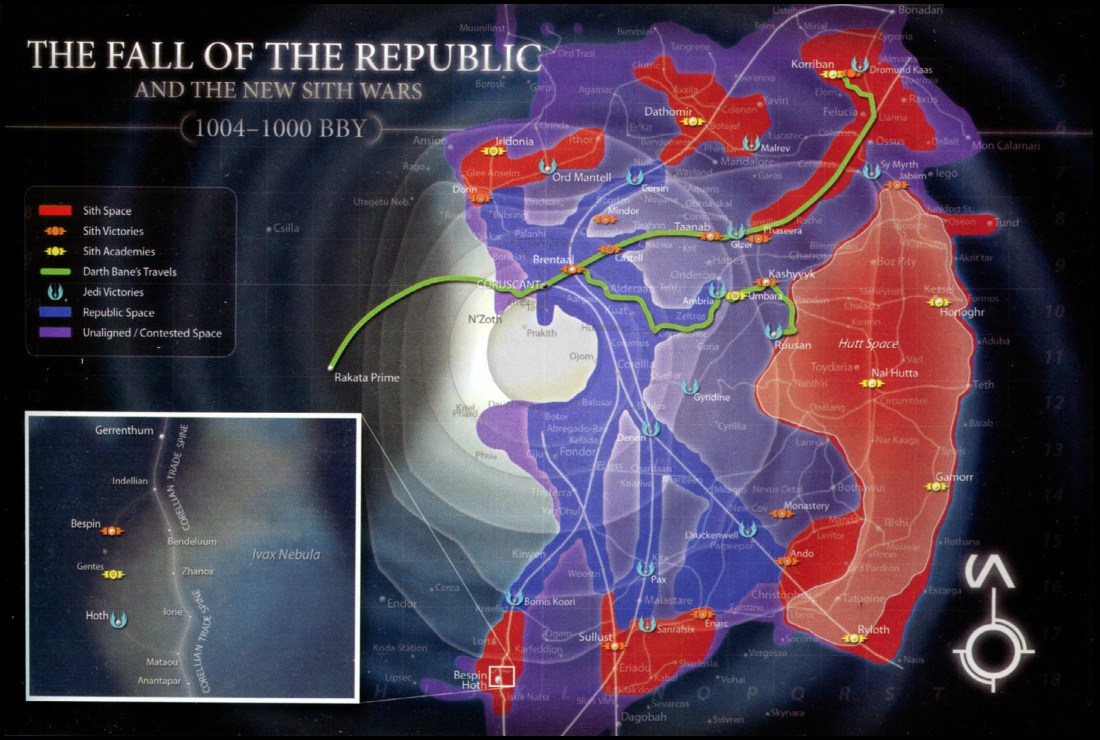
By 3700 BBY, the galaxy had undergone extensive mapping and settlement as far as Farana in the north and Malastare in the south. However, significant portions of the northern and southern quadrants beyond the primary trade routes remained sparsely populated. Around this time, Freia Kallea, an explorer born on Brentaal, extended the ancient Brentaal–Denon Route and connected several pre-existing praediums. By 3693 BBY, she had expanded the trade routes south of Denon to reach Imynusoph, effectively mapping the entire length of the Hydian Way, which was the sole super-hyperroute to traverse the galaxy's length. The enhanced accessibility to the northern and southern quadrants significantly expanded the Republic's reach into the New Territories and the Western Reaches, unlocking countless new sources of minerals, crystals, and gases. However, from 3681 to 3642 BBY, the Republic endured decades of war and tension with a resurgent Sith Empire composed of exiles from the Great Hyperspace War, and led by the Sith Emperor Vitiate. A second Galactic War erupted between the two factions in 3642 BBY, and chaos ensued until the Sith Emperor's stronghold, the Eternal Empire, was vanquished.
Following these conflicts, the galaxy experienced several centuries of relative prosperity, which came to an end in 2000 BBY with the advent of the Draggulch Period and the commencement of the New Sith Wars when the Jedi Master Phanius proclaimed himself Darth Ruin. During the ensuing millennium of conflict between the Republic and the New Sith, the Republic teetered on the brink of collapse, culminating in the Republic Dark Age during the final century. During this time, the Republic's authority effectively evaporated beyond the major trade routes, and the HoloNet communications network ceased to function. The New Sith Wars ultimately concluded when the Army of Light, led by the Jedi Lord Hoth, defeated Skere Kaan's Brotherhood of Darkness at the Seventh Battle of Ruusan. A solitary Sith Lord, Darth Bane, managed to escape and establish a new Sith order, while Supreme Chancellor Tarsus Valorum proclaimed the Ruusan Reformations, which served to rebuild the Republic from its foundations.
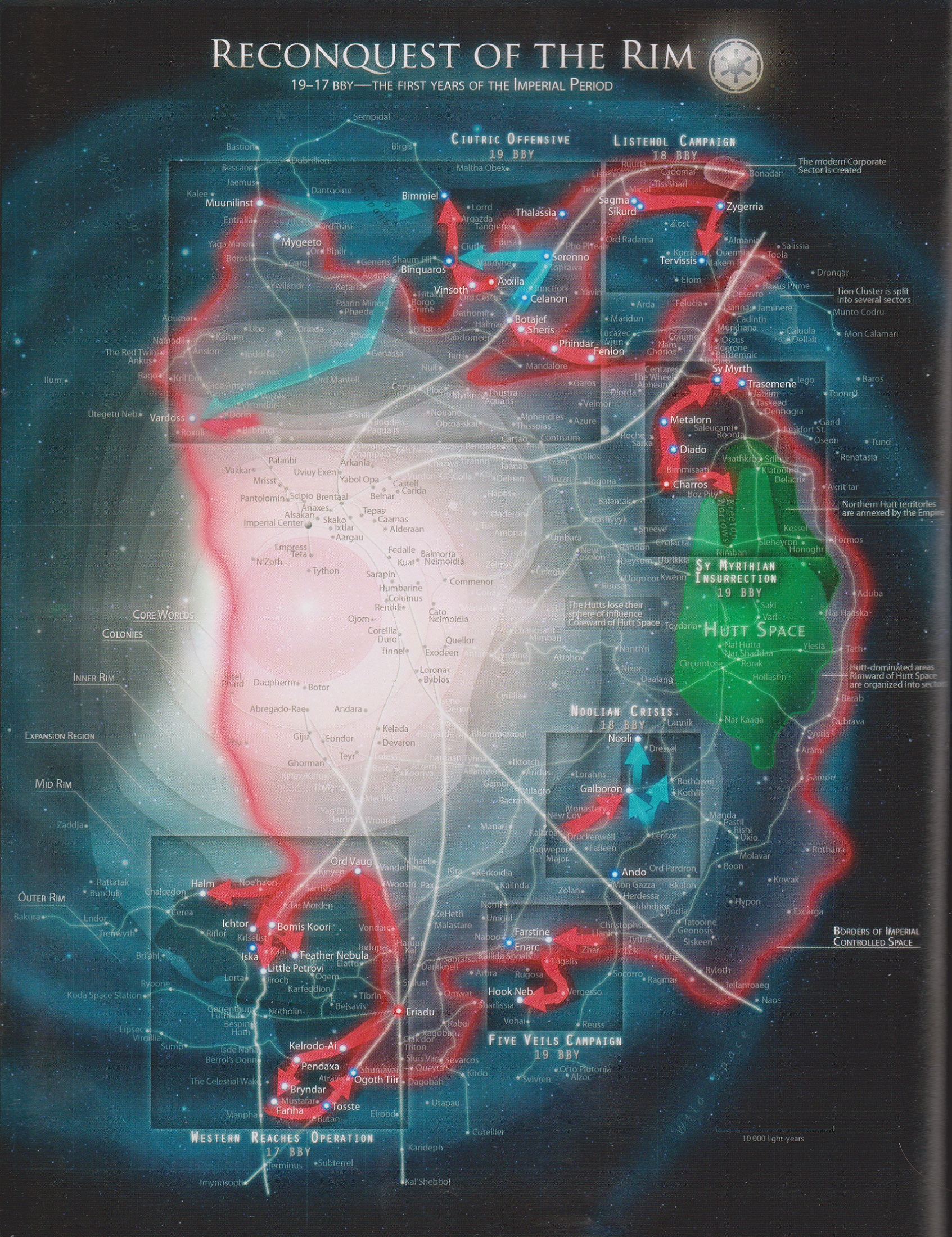
The Republic's final millennium was primarily characterized by peace, but the stipulations of the Ruusan Reformations led to increased lawlessness in the Outer Rim Territories, which eventually fell under the control of megacorporations and criminal cartels. This discontent was exploited by the Sith, who had remained hidden for a millennium, to instigate a Separatist movement. By orchestrating the Clone Wars, the Order of the Sith Lords succeeded in destroying the Jedi Order and restoring their Empire under Darth Sidious. Sidious dismantled the Republic and replaced it with the short-lived Galactic Empire, ultimately abolishing the Republic's institutions entirely. One lasting consequence of Imperial rule was the opening and extensive settlement of the Deep Core, as well as the mapping and exploration of a substantial portion of the Unknown Regions. The Empire endured for two decades marked by tyranny, but following the Galactic Civil War and the death of Darth Sidious at the hands of Anakin and Luke Skywalker, a New Republic was established by an alliance of free worlds. Nevertheless, the remnants of the Empire continued to resist the new government for over a decade before finally signing a peace treaty.
The Yuuzhan Vong War represented a pivotal moment in galactic history, marking the first instance of an extra-galactic power invading the galaxy. The brutality of the conflict would shape galactic politics for more than a century thereafter. Shortly after the conclusion of the Galactic Civil War, an extra-galactic species known as the Yuuzhan Vong launched an invasion of the galaxy. The Yuuzhan Vong War wrought devastation across much of the galaxy, including Coruscant, and resulted in the deaths of approximately 365 trillion beings. However, they were eventually defeated by a new Galactic Alliance comprising the Imperial Remnant, remnants of the New Republic, and numerous minor powers within the galaxy. Another outcome of the war was the normalization of relations between the galaxy proper and the Chiss Ascendancy, the dominant power in the Unknown Regions. Within a few decades, stable hyperroutes and colonies had been established in the region, diminishing much of its mystique.
While some Yuuzhan Vong were integrated into the galactic community, the post-Yuuzhan Vong War galaxy proved exceedingly difficult to govern, leading to a Second Galactic Civil War between the Galactic Alliance and a Confederation spearheaded by Corellia. Within a century, the Galactic Empire had been restored under the Fel dynasty, although without Sith backing this time. Ultimately, the Fel Empire was manipulated by the One Sith, led by Darth Krayt, into declaring war on the Galactic Alliance. The Sith achieved this by exploiting lingering animosity towards the Yuuzhan Vong, making it appear as though they were planning to re-conquer the galaxy. Shortly thereafter, the One Sith usurped the Imperial throne, establishing a new Sith empire. However, the resulting war between the Sith and the Galactic Alliance Remnant, as well as the Fel-loyalist Empire-in-exile, culminated in the Sith's defeat. Subsequently, the Galactic Alliance once again became the dominant governing body in the galaxy once again.
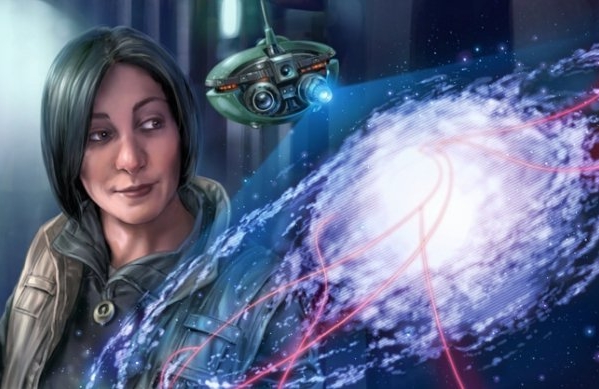
The foundation of galactic civilization rested on clear and reliable pathways through hyperspace, which were referred to as hyperlanes or hyperroutes. These hyperlanes offered secure routes for starships, circumventing the perilous gravitic "mass shadows" that objects in realspace cast into hyperspace. Spacers who were hyperspace explorers such as Aitro Koornacht, Jori, and Gav Daragon charted and established these routes. Here are some significant routes that played a role in shaping galactic history.
The galaxy's largest, longest, and fastest hyperlanes were the super-hyperroutes, with some spanning from the Core Worlds to the Outer Rim edges. The Perlemian Trade Route and the Corellian Run were the two oldest, both created after the hyperdrive was developed in 25,000 BBY. The Perlemian formed the northern boundary of the Slice, linking the galactic capital of Coruscant with the Jedi training world of Ossus and the Tion Hegemony civilizations. Colonies and species along the Perlemian's expanse requested Republic protection from the Tionese or the Hutts early in the Republic's history, which fueled the Republic's rapid expansion. The Perlemian, poetically known as "the Axis," was initially dominated by Alsakan, which started the socio-economic divide that led to the Alsakan Conflicts. The Perlemian terminated in Wild Space beyond Quermia at the galaxy's edge.
The Corellian Run secured Corellia's economic dominance within the emerging Republic and established the Slice's southern border. The section of the Run Coreward of Corellia, known as "the Spin," was initially controlled by Coruscant, creating a divide with the Spin and Alsakan. However, Rimward of Corellia, Corellians and Humans of Corellian descent held significant economic power in the sectors surrounding the Run for millennia. With the rapid establishment of the two oldest hyperroutes, exploration in and around the Slice became easier, resulting in a population boom that shaped the galaxy's settlement patterns.
The Corellian Trade Spine was established in 5500 BBY, although the first route existed as early as 25,000 BBY, connecting Corellia and Duro. At Yag'Dhul, the Trade Spine intersected the Rimma Trade Route before extending Rimward to the Greater Javin and past Terminus. The Corellian Trade Spine, while providing rapid transit into the galactic southern quadrant, never offered the same economic advantages as the Rimma Trade Route. Around the same time, Givin hyperspatial cartographers plotted the Rimma, and Sullustan scouts blazed it out of Herglic Space. The Rimma facilitated the widespread colonization of the southern quadrant and enriched the Tapani sector worlds in the Colonies. Significant planets along the Rimma included the wealthy industrialized world of Eriadu at the junction with the Hydian Way, the Bith homeworld of Clak'dor VII, and the shipyards of Sluis Van.
The Hydian Way, the last super-hyperroute established, was the only one to span the galaxy's entire length. Freia Kallea, a Brentaal-based scout, was primarily responsible for its creation. Around 3700 BBY, she extended the ancient Brentaal–Denon Route eastward, connecting several obscure routes into a single passage that reached the northern quadrant's galactic edge. She then ventured south of Denon, pioneering new routes to the galaxy's Rim in the southern quadrant and opening vast areas of space for new colonization.
The Metellos Trade Route was established west of Coruscant into the Negs in a failed attempt to find a western equivalent to the Perlemian Trade Route. Its expansion stalled due to the hyperspace eddies near the Unknown Regions, and explorers could only extend its length by a few light-years each century until it ended in the Farlax sector. The Koros Trunk Line, an ancient pre-Republic route connecting Coruscant to the carbonite mines of the Koros system, was a more successful Core Worlds hyperroute. The route became known as the Carbonite Pipeline because it transported so much ore after the hyperdrive's development, since carbonite was crucial for keeping sleeper ships passengers in suspended animation.
The Salin Corridor, one of the Outer Rim's oldest hyperlanes, was originally created by Xim the Despot's empire as the Warrior's Trace to support his wars with the Hutts. It was maintained by a "lighthouse network" of jump beacons. Although many Xim-era beacons had disappeared, the Salin Corridor's stability intrigued hyperspace theorists for millennia. As one of the Outer Rim's longest routes, it began near Aduba in the Hutt-controlled Rim worlds, meandered Coreward around Hutt Space's tip, turned north into the Tion Cluster edges, skirted the Radama Void, intersected the Hydian Way at Botajef, and ended in the northern quadrant.
The Braxant Run, the northern quadrant's most important route, began at Bandomeer on the Hydian and twisted across the New Territories via Muunilinst to Bastion. The Triellus Trade Route, the third of the Outer Rim's three most important routes, spanned over 75,000 light-years from Centares to Enarc, forming one side of the "Spice Triangle." However, travel along the "Hutt Highway" was often slow and dangerous due to smugglers, slavers, and pirates operating from Hutt Space.
The Ootmian Pabol connected the Expansion Region's financial hubs with the heart of Hutt Space. Derived from the Huttese phrase Ootmian Pankapolla, it was established around 12,000 BBY from Gyndine to Nal Hutta by Republic scouts. Thriving trade transformed Nal Hutta's moon, Nar Shaddaa, into a boomworld. However, the supernova of the Kyyr system star in 4000 BBY rendered the route impassable. The Ootmian was eventually restored, but the rise of the Corellian Run ended Nar Shaddaa's status as a respectable tradeworld. Legitimate business moved elsewhere, and the moon became one of the galaxy's most infamous shadowports. It was speculated that the Kyyr supernova caused the Hutt kajidics to shift towards criminal activities.
Some routes, particularly those used for smuggling, were used for illicit purposes. The Kessel Run, an 18.5 parsec three-stop route between Kessel and an area south of the Si'Klaata Cluster, was one of the most notorious examples of illegal routes. During the Galactic Empire reign, smugglers used it to transport Glitterstim spice without being caught by Imperial ships. In addition to the two aforementioned locations, it also connected to the Kessel Trade Corridor, the Triellus Trade Route, and the Pabol Sleheyron routes. Han Solo, a notorious smuggler, claimed to have navigated the Kessel Run in under 12 parsecs with his ship, the Millennium Falcon, by skirting close to the black holes that formed part of the Kessel Run.
The Ison Corridor, a relatively small route within the Corellian Trade Spine, had five system stops before rejoining the Spine, connecting the coreward and rimward regions.
The Sisar Run was a hyperspace trade route that originated in the Tharin sector, passed through the Periphery's heart, crossed Hutt Space and Srillur, bypassed the Si'Klatta Cluster, and split at Sispe. It connected with the Salin Corridor, the Pabol Hutta, the Pabol Sleheyron, and the Ac'fren Spur routes.
Myto's Arrow, named after its discoverer, Galactic Republic scout Keos Myto, was an Outer Rim route used to travel between the Raioballo sector via Dantooine and the Obtrexta sector. It was connected to the Veragi Trade Route and the Braxant Run.
The Daragon Trail, renowned as the longest successful blind jump in galactic history, traveled between Korriban in the Outer Rim and Empress Teta (formerly Koros Major) in the Deep Core. It was named after Gav and Jori Daragon, the couple who discovered it in 5000 BBY. Parts of it were incorporated into the smuggling route Carbonite Run.
The Galactic Senate, a legislative body, represented the galaxy's peoples under the Galactic Republic. Originally, any sufficiently populated star system could elect a senator, but this idea was soon abandoned due to the Republic's massive expansion and the thousands of delegates attending Senate meetings, which would have resulted in gridlock. The Planetary Senate was replaced by sectorial representation. The Republic was divided into sectors, each containing no more than fifty inhabited systems (larger sectors were feared to become the seeds of breakaway empires), and each sector was represented by a single sectorial senator. However, this amendment's passage required additional legislation that allowed many of the Republic's Core Founders to retain their planetary seats, giving the most powerful Core and Colonies sectors extra votes.
Strict Galactic Constitutionalists considered this the Republic's "founding tyranny," a cynical attempt to maintain the Core systems' power. The awarding of single-system votes caused such a public outcry that a compromise was reached: anyone recognized as a representative of a single system had the right to petition the full Senate, a right still occasionally exercised under the New Republic Senate.
Sectors grew to include thousands of star systems, but even with the "rule of fifty" widely ignored, the Republic expanded to include millions of sectors by 17,000 BBY, again making the galaxy ungovernable. Following the First Alsakan Conflict, the Challat Compromise was adopted, dividing the legislature into a seated Senate, whose members had full rights of address, and an unseated Senate, whose members had to petition for such rights. Predictably, the seated senators became power brokers, and corruption flourished, with unseated senators trading most of their votes for the chance to be heard in the Senate.
The Ruusan Reformations of 1000 BBY remarkably dismantled central authority and reorganized the Republic into 1,024 regional sectors, each represented by a single senator, although exceptions again favored planets in the Core and Colonies. The right of representation was also extended to functional constituencies representing distinct cultural and species enclaves. While the galaxy was again governable, the Reformations inevitably placed power in the hands of a select few, especially when the definition of functional constituencies was extended in 124 BBY to the galaxy's most powerful guilds and corporations, most notably the Trade Federation. The Trade Federation acquired vast blocs of votes from poor sectors and gained control of key appointments in the bureaucracy. By the time of the Separatist Crisis, it was the Senate's greatest power and paralyzed the Senate in the face of the Confederacy of Independent Systems.
Palpatine stripped the Senate of most of its power during the Clone Wars and completely dissolved the Imperial Senate in 0 BBY. The New Republic restored the body, but it inevitably became mired in gridlock, archaic tradition, and corruption. When the New Republic was reorganized into the Galactic Federation of Free Alliances during the Yuuzhan Vong War, the new state's name seemed to acknowledge the need for decentralization of power. However, post-Yuuzhan Vong War galaxy rehabilitation efforts heavily relied on centralized power, leading to independent-minded systems rebelling in a Confederation led by Corellia, and thus the ancient problem of galactic democracy began a Second Galactic Civil War.
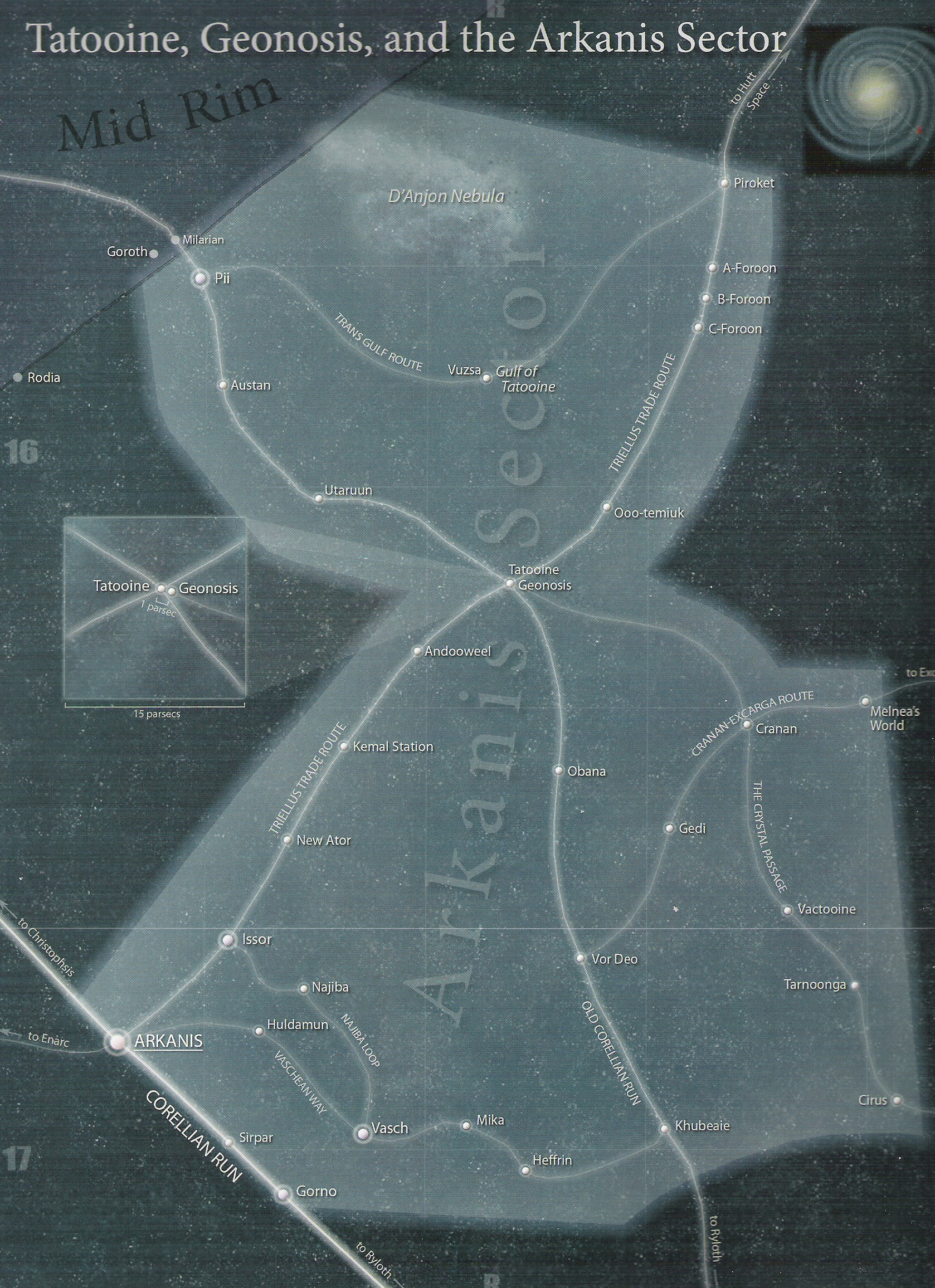
The sector, a largely artificial division of space organized for political, military, and economic reasons, served as the basic political unit for much of galactic history. After the Galactic Republic's early years, its star systems were organized into sectors limited to fifty systems with substantial populations. As the Republic expanded, the vast number of sectors caused gridlock in the Galactic Senate, and some sectors grew to include thousands of inhabited worlds, even as galactic civilization continued to expand wildly, until there were millions of sectors.
The Ruusan Reformations of 1000 BBY resolved this issue by reorganizing the galaxy into 1,024 regional sectors divided into constituent subsectors. For example, the Chommell sector of the Mid Rim, though sparsely settled, contained about forty thousand inhabited worlds. By 0 BBY, sectors included cultural groupings like the Tapani sector and the Senex-Juvex, and business-controlled economic areas like the Corporate Sector, but they were generally arbitrary groupings of planets and colonies with varying fates and cultures, such as the Gordian Reach, the Arkanis sector, and the Anoat sector.
The Ruusan Reformations created several problems with sectorial representation that persisted until the Republic's end. A moratorium was placed on creating new sectors, but settlers continued to push beyond the Republic's frontier, reclaiming systems lost during the New Sith Wars and settling new worlds. Some systems were annexed by existing sectors, causing some outlying sectors to expand to enormous sizes. Others became de facto corporate possessions or were directly administered by the Republic bureaucracy and denied Senate representation, although it was claimed that they were "virtually represented" by other senators. The old Core sectors viewed the rimward megasectors as a threat to their ancient power and prestige, while the directly administered systems complained that their "virtual representation" was a farce. The reforms of 124 BBY sought to address these issues, with many settled areas outside the Republic's borders becoming incorporated as freestanding subsectors, and their representatives reported to the senator of an associated sector.
Until the Galactic Republic's final years, sectors were governed by their senators, while the Supreme Chancellor could appoint a Governor-General to coordinate military action within the sector during a state of emergency. Palpatine frequently exploited this law during the Clone Wars, culminating in the Sector Governance Decree, which appointed a permanent new class of military governors to the regional sectors: the Galactic Empire's Moffs. The Galactic Empire also created or carved out new sectors, overturning the Ruusan Reformations' moratorium. This included the Indrexu sector in the Greater Tion, and combining several freestanding subsectors to create the Baxel and Zuma sectors.
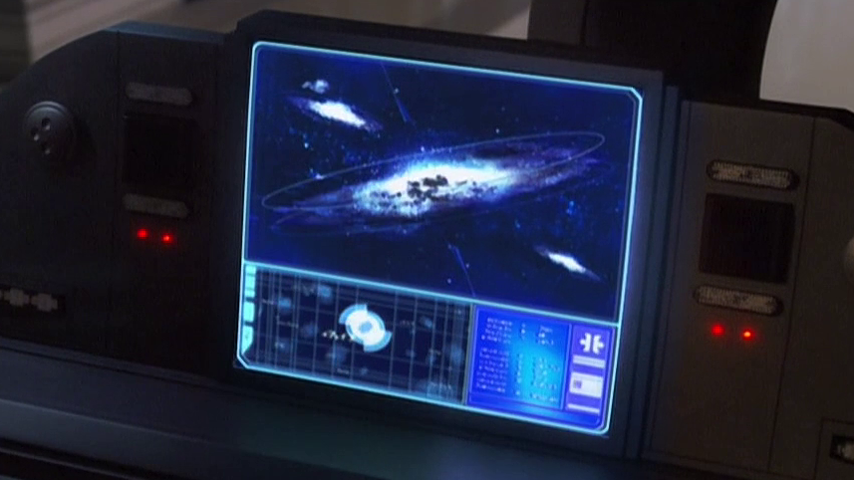
In the Galactic Republic's early years, any planet with a sufficiently large population was granted a seat in the Galactic Senate. However, even before the Galactic Republic expanded beyond the Core Worlds, this governmental system proved unworkable. The Senate's size made debate endless and consensus nearly impossible. The Planetary Senate was reorganized, with sectors formed from groups of up to fifty star systems to serve as the new constituencies. However, recognized representatives of a single planet or species still had the right to petition the full Senate. Jar Jar Binks, representing the Gungan people of Naboo, was a prominent example of this near the Republic's end.
Planetary Governors represented the central government on a single planet. Their authority typically extended to the entire star system, with exceptions for systems containing multiple planets with large populations or very different cultures, such as the Corellian system. In the Core Worlds' oldest regions, systems and even individual planets were centers of political power, a remnant of the Galactic Republic's origins. Elsewhere, systems were subordinate in representation to subsectors, sectors, and regions.
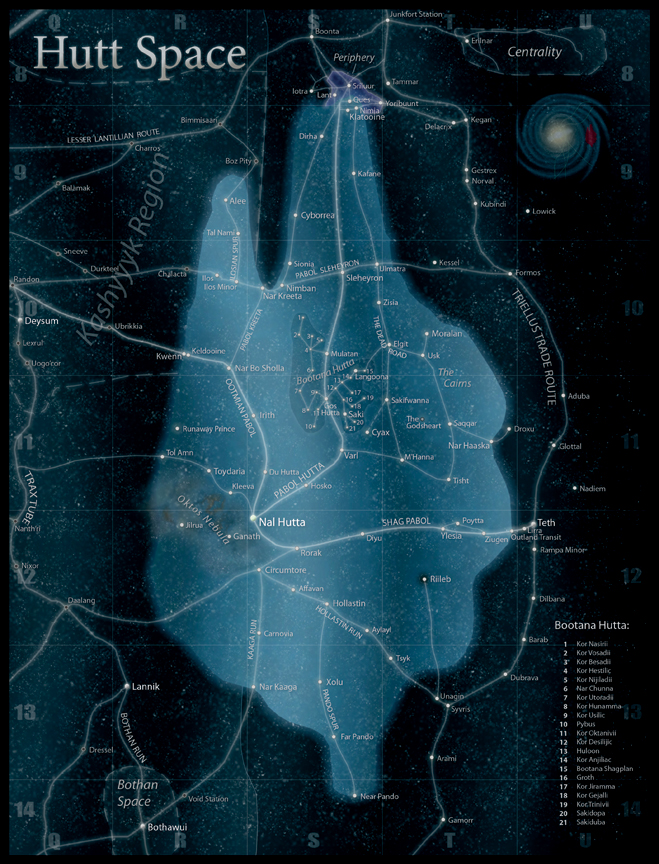
The Allied Regions were independent states that voluntarily joined the Galactic Republic as it expanded early in its history, with their rulers receiving the honorary title of Moff. By the Clone Wars, most Allied Regions had been divided into sectors, but some persisted as regions with a distinct cultural identity, such as the Trailing Sectors or the New Territories, or a sector dominated by a single species, such as Trianii Space. Several of these governments survived as client states under the Galactic Empire and maintained some independence, and were recognized by the New Republic afterward.
Hutt Space encompassed the large stretch of the Rimward Slice controlled by the Hutt Ruling Council, the Hutt species' governing body. The Hutt Empire, originally powerful warriors, overthrew Xim the Despot's empire, but a disastrous civil war around 15,000 BBY, known as the Hutt Cataclysms, forced a cultural reformation, beginning a new philosophy called kajidic, which emphasized economic dominance over outright conquest. Hutt Space's borders fluctuated over the millennia, but the Hutts' power in the economic and criminal spheres endured, extending Coreward to Gyndine as the Galactic Republic declined during the Separatist Crisis. Hutt Space was nominally part of the Galactic Empire, but the New Order largely tolerated the Hutts' criminal activities, as the Hutt Ruling Council was a known entity compared to the potential chaos of hundreds of feuding Hutt crime lords. Hutt Space was devastated during the Yuuzhan Vong War, but recovered surprisingly quickly, leading to a renewed Hutt militarism that manifested when the region declared for the Confederation during the Second Galactic Civil War.
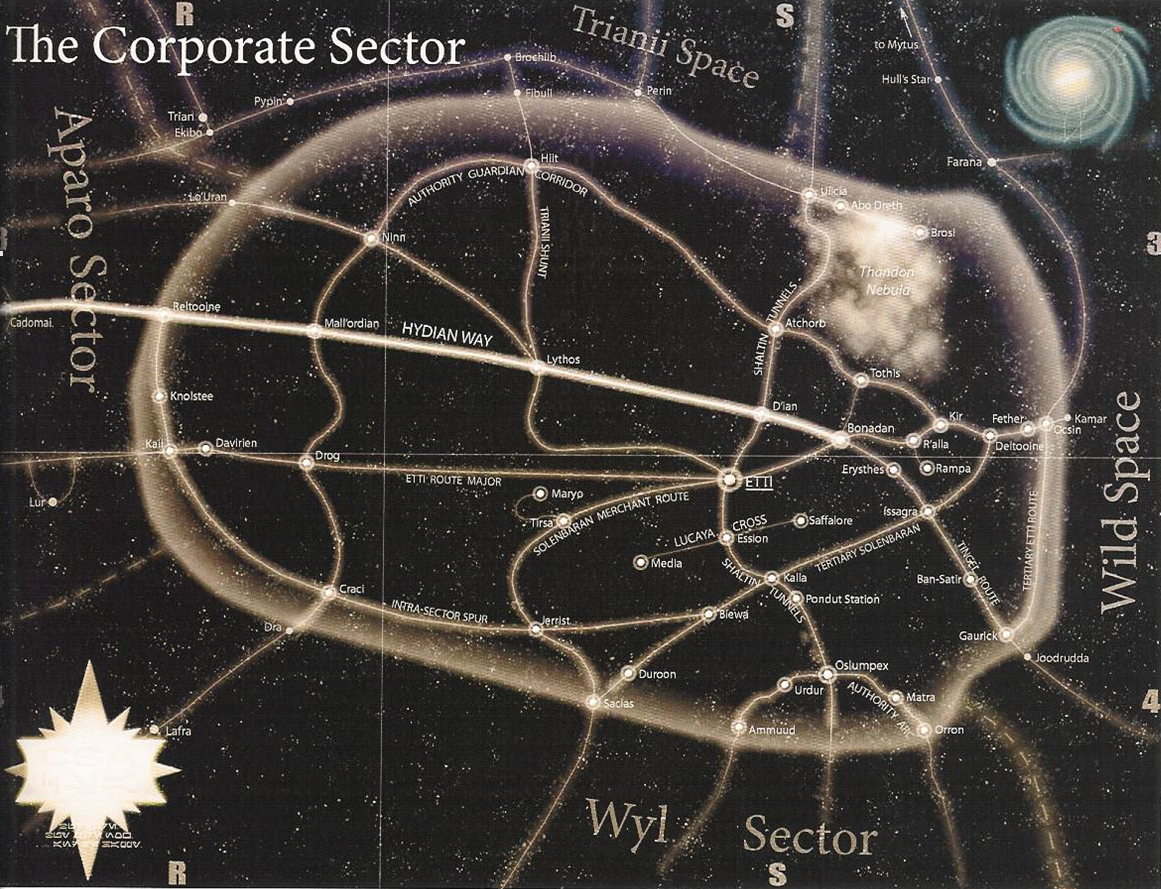
The Corporate Sector Authority (CSA) was the governing body of the Corporate Sector, a collection of nearly thirty thousand star systems situated on the fringe of the Tingel Arm. This region was administered from Etti IV by a consortium of businesses and corporations, who held exclusive rights to all resources within the territory. This experiment in corporate governance, designed to safeguard worker rights, was initiated following the lessons learned from the Outer Expansion Zone scandal. Baron Orman Tagge's suggestion led to a significant expansion of the Corporate Sector under the Galactic Empire, transforming it into a formally recognized sanctuary for Loyalist corporations seeking to avoid nationalization. The CSA acted as the region's sole owner, employer, government, and military force, with corporations investing in the Authority receiving shares of the profits proportional to their investment.
Established in 3350 BBY, the Centrality was a state founded as a libertarian independent zone situated to the north of Hutt Space. Predominantly populated by Humans, its capital, Erilnar, was frequently influenced by the Hutt kajidics, who often reaped the rewards from the Centrality's primary export: the life-crystals of Rafa V. Although officially an Imperial territory, Imperial Center generally left the Centrality undisturbed. Emperor Palpatine's only intervention in the region occurred some years before the Battle of Yavin, when he granted de facto control of the Centrality to Rokur Gepta, the Sorcerer of Tund, who was later killed by Lando Calrissian in defense of the indigenous Oswaft during the Battle of ThonBoka.
The Hapes Consortium served as the monarchical government of the Hapes Cluster, which was located in the Inner Rim. The Hapans, known for their isolationist tendencies and matriarchal society, gained renown for their fabled wealth, beauty, pride, and internecine aristocratic conflicts. Many were surprised by Emperor Palpatine's tolerance of the region's autonomy, with some suggesting that the Emperor maintained Hapes as a cautionary example to the galaxy, illustrating the perils of insularity and decadence. After the Declaration of a New Republic, the Hapes Consortium chose to open its borders.
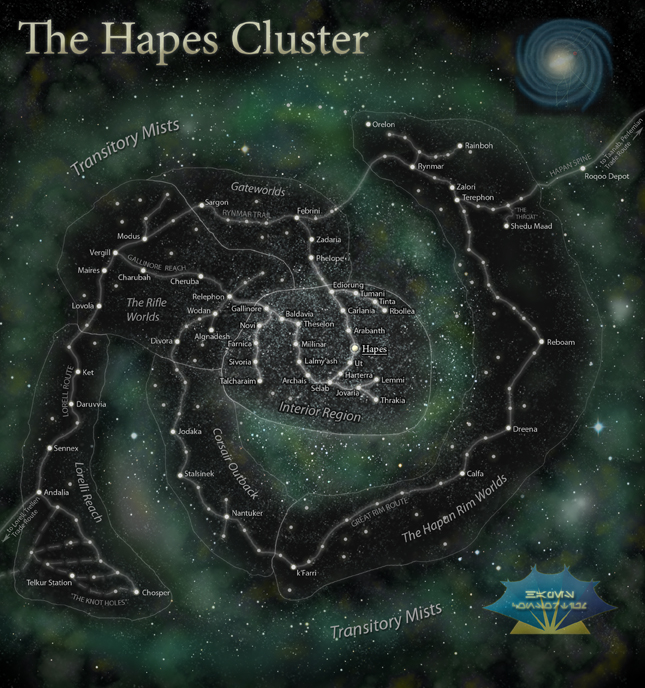
The Atrisian Commonwealth encompassed a region of two hundred planets situated in the Core Worlds, near the Unknown Regions. The writings of Atrisia, particularly the Sayings of Uueg Tching, which covered political, diplomatic, and military matters, had been studied for thousands of years. This secluded territory declared its independence following Emperor Palpatine's demise at Endor, but later accepted Allied Region status within the New Republic. Similarly, Nouane began as a prosperous Inner Rim empire beyond the Slice, famous for its philosophers and thinkers, particularly the controversial Four Sages of Dwartii. Nouanese ministers were frequently found in the early Republic, and the territory sought Allied Region status after being devastated by the Mandalorian Crusaders in 3963 BBY. This region, consisting of 212 planets, was a staunch supporter of the Empire and declared independence under the New Republic.
Bothan Space comprised approximately 150 settled systems in the Mid Rim, dominated by Bothan colonists and governed by the Bothan Council. The Bothans, one of the few species near Hutt Space to maintain their independence, were credited with the diplomacy and espionage that preserved stability in much of the Mid Rim. In 4 ABY, Bothan Space was among the first regions to announce its support for the New Republic.
Located on the fringe of the Core, the Botor Enclave and the Daupherm Planet States were two adjacent territories. The ursine Botori controlled around two dozen star systems within a nebula, while the Human Dawferim governed slightly over thirty systems. Despite accepting Allied Region status under the Galactic Republic, the two states had engaged in no fewer than forty wars, and both declared independence after the Declaration of a New Republic.
Herglic Space was the term used to refer to the diminished remains of the Herglic Trade Empire. It was made up of about forty star systems surrounding the Rimma Trade Route, however, substantial Herglic populations existed on hundreds of worlds along the Rimma outside Herglic Space. The Empire brutally suppressed Herglic Space, but it regained Allied Region status under the New Republic and the Galactic Federation of Free Alliances.
The Ktilac Regions, situated off the Perlemian Trade Route in the Inner Rim, were a confederacy ruled by three species: the Ktilacs, the Murachaun, and the Tocoyans. This religiously fundamentalist region had cultivated a shared culture where each species was seen as complementary to the other two, while the rest of the galaxy was viewed as unholy. Each species governed sixty-three star systems, with an additional three open to outsiders under strict regulations. The Regions maintained Allied Region status under the Galactic Alliance.
Paqwepori was a compact cluster of ninety affluent star systems located just off the Corellian Run in the Mid Rim. The bazaars of Paqwepor Major were favored destinations for Republic traders expanding the Corellian Run for centuries. The Paqwepori were renowned for their entrepreneurial spirit and ambition, while they despised any law that might restrict individual expression or initiative.
The expansion of technology and civilization across the galaxy resulted in the evolution of the galactic economy, which is the system responsible for the production, distribution, trade, and consumption of goods. Very few planets were completely self-sufficient; some, like the factory worlds of Telti and Mechis III, dedicated their economies exclusively to producing high-tech goods but relied on agriworlds for food. In turn, these agriworlds depended on manufacturing worlds for the heavy equipment needed to harvest and process foodstuffs, as well as chemical industries for the production of fertilizers and pesticides.
The significance of the galactic economy allowed numerous megacorporations to amass considerable economic and political influence. In the years leading up to the Clone Wars, the Trade Federation, a consortium of shipping and merchant cartels, controlled the votes of hundreds of star systems in the Galactic Senate by making their commerce reliant on its Merchant Fleet and enforcing deals with the Trade Defense Force. Companies such as the SoroSuub Corporation, which under the Empire directly controlled the government of the planet Sullust, produced goods for a wide array of sectors. TaggeCo controlled hundreds of star systems and numerous subsidiaries, making it one of the galaxy's most powerful organizations. Even smaller businesses, such as the Figg conglomerate in the Greater Javin, wielded significant influence in their homeworlds and sectors.
The primary currency of the Galactic Republic was the Galactic Credit Standard, which was divided into ten decicreds.
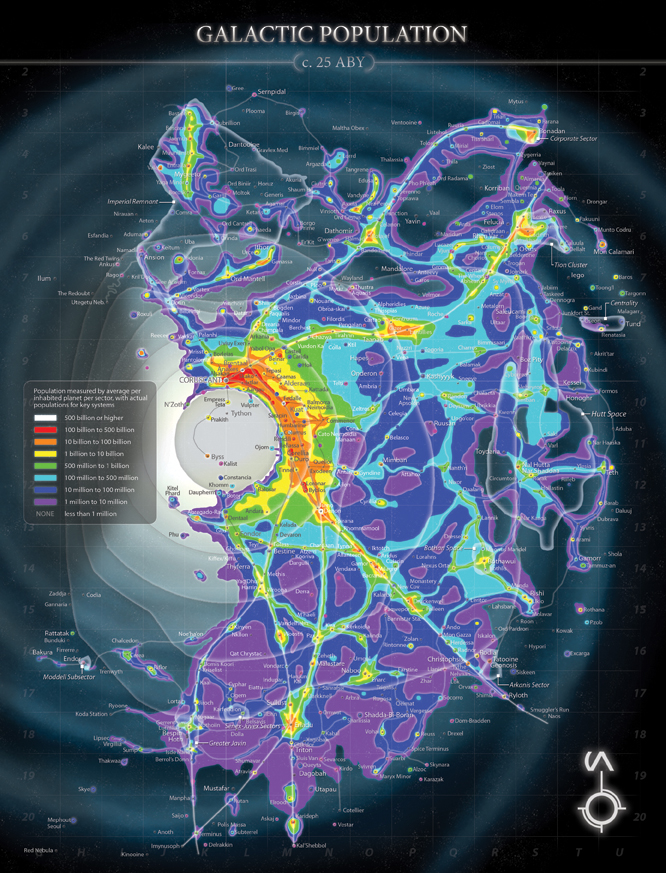
Of the galaxy's one billion inhabited systems, the majority were sparsely populated colonies of little consequence, often not even marked on sector maps. The Chommell sector, for example, contained thirty-six worlds with sufficient population to warrant representation in the Galactic Republic, but also included 40,000 settled dependencies, in addition to 300,000,000 barren, uninhabited stars.
During the era of the Galactic Empire, over 69 million systems met the criteria for Imperial representation, and 1.75 million planets were considered full member worlds. The population of the nearly 70 million systems under the Empire's jurisdiction exceeded 100 quadrillion individuals.
Scientists were uncertain about the true number of intelligent species due to the fact that only about a quarter of the galaxy's four hundred billion stars had been thoroughly surveyed. The Galactic Empire recognized five million intelligent species, although it was mathematically accepted that galactic civilization had yet to discover a large number of species and the total could be as high as twenty million.
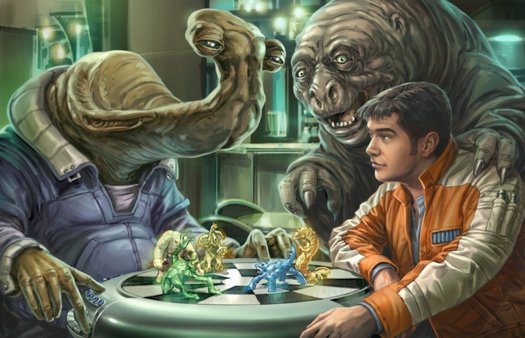
Humans were the dominant species in classical history. Originating from the Core Worlds, Humans were the most numerous species in the galaxy and therefore tended to form the basis of the major governments. Sentient beings other than Humans were sometimes referred to as "aliens," though the term "non-Human" was considered less offensive. Nevertheless, the Humanocentric definition of races was deemed unacceptable by some, viewed as merely another manifestation of unwarranted Human dominance. Other notable spacefaring species included the Baragwin, who had long forgotten their homeworld and traveled the galaxy as merchants; the Duros, a founding species of the Republic and inventors of the modern hyperdrive; the Herglics of Giju, who established the Rimma Trade Route; the Gran of Kinyen, who had settled countless colonies, including Malastare; and the Ithorians, who had long maintained large networks of Herdships for galactic trade, relocating their civilization there after Ithor was devastated during the Yuuzhan Vong War.
Although not considered a race for obvious reasons, droids were an important element of society, assisting and coexisting with the population. On Naboo, higher level droids were regarded as equals and fellow sentients.

Due to a circumferential hyperspace barrier that prevented hyperspace routes very far outside the disk, and beyond this, the barren vastness of the Intergalactic Void, extra-galactic travel was difficult. However, by the time of the Clone Wars, contact had been made with the two small galaxies orbiting the galaxy: the Rishi Maze, also known as Companion Aurek, and Firefist, also known as Companion Besh. The InterGalactic Banking Clan had influence as far as these locations.
The Extragalactic Society was a group dedicated to finding life outside the galaxy. Around the time of the Clone Wars, two significant expeditions were launched to explore beyond the galaxy: the Outbound Flight Project was intended to establish a settlement in another galaxy but was destroyed by the Chiss after it accidentally entered their territory in the Unknown Regions. In 19 BBY, during the final days of the Republic, Senator Grebleips, the Brodo Asogi leader, launched an expedition to another galaxy, but the result of this mission remains unknown.

Shortly after the Battle of Endor, the Nagai and the Tofs, peoples indigenous to the companion galaxy of Firefist, invaded the galaxy. The Nagai hoped to escape the Tofs, who had oppressed them for centuries. With assistance from the Alliance of Free Planets and the Mandalorians, the Nagai defeated the Tofs and returned to liberate their home galaxy, bringing the Nagai–Tof War to an end.
Among the most well-known extra-galactic aliens were those who had fled from the Yuuzhan Vong galaxy: the droid races of the Abominor and the Silentium, and the Yuuzhan Vong themselves and their slave soldiers, the Chazrach. The Abominor and the Silentium fought a devastating war before the Yuuzhan Vong rose up against both and drove them from their galaxy. Of those Silentium and Abominor that survived, two, the Great Heep and Vuffi Raa, established themselves in the galaxy proper around the time of the Galactic Civil War. The former was destroyed on Biitu and the latter was recovered by the Silentium after the Battle of ThonBoka.
After driving the Silentium and the Abominor from their galaxy, the Yuuzhan Vong turned inward and fought their own civil war, the Cremlevian War, which stripped much of their galaxy of life. Seeking a new home, the Yuuzhan Vong and the Chazrach crossed the Intergalactic Void for millennia until they arrived in the galaxy, beginning a religious war which almost destroyed galactic civilization while it was just recovering from the Galactic Civil War.
Galactic Basic Standard served as the lingua franca of the galaxy, originating as a Human language from Coruscant known as Old Galactic Standard. As the Galactic Republic expanded, Old Galactic Standard was influenced by Durese, Bothese, and Olys Corellisi, evolving into Mid-Galactic Standard by 15,000 BBY. The Dromnyr language influenced the evolution of Mid-Galactic Standard into modern Basic after the Vultans joined the Galactic Republic around 14,000 BBY. As Humans were the dominant species in the galaxy, Basic was also adopted by many non-Human species.
Huttese was the second most common language, spread through the criminal and financial activities of the Hutts. As such, it was adopted throughout the Outer Rim Territories by other species in close cooperation with them throughout the ages, such as the Rodians and the Toydarians.
The dominant writing system in the galaxy was Aurebesh, derived from the script of the Rakatan Infinite Empire by its former subject species after the Empire collapsed, though the symbols themselves were possibly much older. Aurebesh spread throughout the galaxy during the Tionese War between the young Galactic Republic and the Honorable Union of Desevro & Tion, when the new Republic Military found it needed to standardize its communications, and so adopted the writing system of Coruscant. The High Galactic alphabet was the second most-common writing system, promoted by Alsakan after 17,000 BBY during the Alsakan Conflicts as part of its efforts to be recognized as the galactic capital. Derived from Tionese characters, the High Galactic alphabet was popular among the upper class, and as late as 22 BBY, one-third of Republic citizens who spoke Basic used the High Galactic alphabet. Consequently, notices were often written in both Aurebesh and High Galactic.
There has been no real attempt to give the galaxy an official astronomical designation. The descriptive phrase "the Star Wars galaxy" is generally used outside of the fictional universe. According to The Essential Atlas, the Nagai of Firefist call the main galaxy Skyriver, which is the closest any official source has come to providing an in-universe name for the galaxy. However, it remains unknown how the galactic community refers to their own galaxy (similar to how we refer to ours as the "Milky Way").
"The Galaxy Far, Far Away", often shortened to GFFA, is the unofficial name many fans use for the galaxy in which the Star Wars films and related works take place. In the films, this galaxy is simply referred to as "the galaxy." This name comes from the introductory text at the beginning of each film, many video games, and even some fan films and novels:
The acronym GFFA became so widespread that Del Rey named the post-New Jedi Order government, the Galactic Federation of Free Alliances, in its honor.
The opening lines of each Star Wars film suggest that the galaxy exists within the same realm as our own, stating that it is a finite distance—"far, far away"—from us, but no further details about its location have been revealed. Humans exist in both galaxies, and Galactic Basic is essentially the same as modern-day English, encompassing its British, American, New Zealander, Caribbean, and Indian variants. Furthermore, numerous cultural traditions (from the handshake to marriage) are similar or identical in both galaxies, though these similarities remain unexplained.
Similarly, the time frame the galaxy and the events occurring in it occurred in compared to that of Earth is not made clear other than the opening words declaring that they took place "A long time ago." The teaser trailer for A New Hope opened with the line "Somewhere in space, this may all be happening right now..." It should be noted that, originally, when George Lucas was writing the first film in its initial treatment, he had intended for the galaxy to not only occur within the same galaxy as our own, but the time frame would have been specifically cited as occurring within the thirty-third century. Walter Murch, an associate of Lucas' since his days working at American Zoetrope, implied that part of the reason for the decision to change the setting to occurring in a galaxy "far, far away" from our own was so Lucas could both make the movie and at the same time get away with pushing anti-Vietnam War messaging in the film as a transubstantiated remake of Apocalypse Now, as he could not get the message out directly due to the events of Vietnam still occurring at the time Lucas started making Star Wars. George Lucas in The Making of Star Wars gave a similar reason for the change.
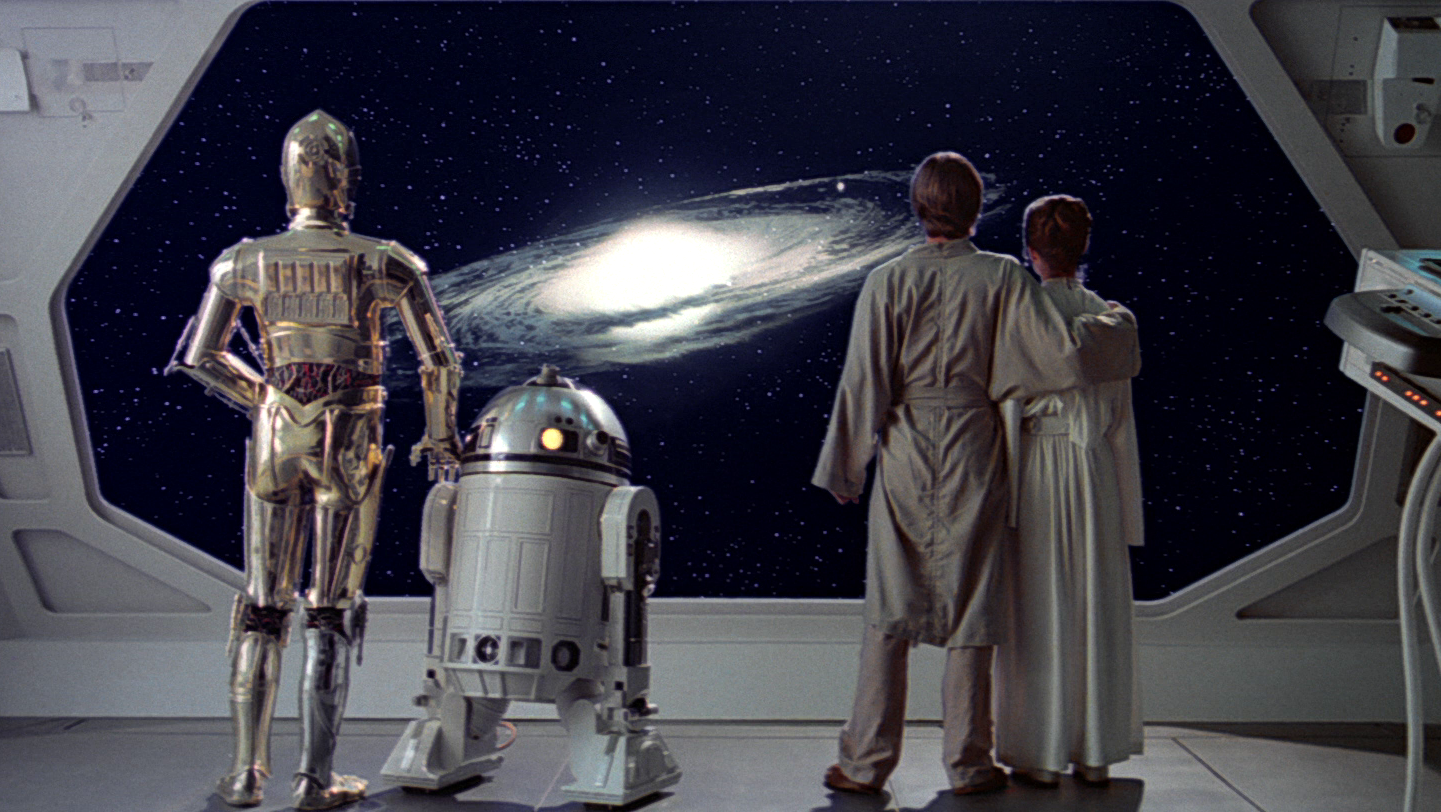
At the conclusion of Star Wars: Episode V - The Empire Strikes Back, the characters, who are located on vessels belonging to the Rebel fleet, observe a distant cosmic entity. Some viewers have posited that its rotational velocity is implausibly high for a galaxy, and furthermore, that a galaxy at such a distance would not exhibit the level of luminosity depicted in the movie.
Certain accounts suggest that the fleet spent a period of time concealed beyond the galactic plane, presumably in reference to the aforementioned scene. However, according to the short story Of Possible Futures: The Tale of Zuckuss and 4-LOM from the 1996 anthology Tales of the Bounty Hunters, the object displayed in the film is indeed the galaxy, and the Rebel fleet had traveled to a location in space significantly elevated above the galactic plane. This location was not necessarily outside the galactic plane, but rather situated at a point above it.
Following the publication of Tales of the Bounty Hunters, the identity of the object has been presented inconsistently across various sources. The Complete Star Wars Trilogy Scrapbook, initially published in 1997, describes the object as a rotating star formation. In 2002, the Episode II DVD-ROM Exclusive Content proposed that the luminous object could potentially be the star cluster referred to as the Rishi Maze. In 2003, Leland Chee verified on the StarWars.com Message Boards that the object was in fact the Star Wars galaxy itself, a detail that was further substantiated by the 2009 release of The Essential Atlas, which confirmed that the Rebel fleet had regrouped at a location situated above the galactic plane.
Several published works have included galactic "maps," though these are essentially two-dimensional projections representing a three-dimensional galaxy. The earliest maps of the Star Wars galaxy appeared in roleplaying game sourcebooks produced by West End Games, featuring detailed maps of specific regions and sectors. The Elrood sector was charted in Planets of the Galaxy, Volume Three, the Brak sector in Flashpoint! Brak Sector, the Kathol sector in The DarkStryder Campaign, and the Tapani sector along with the Rimma Trade Route in Lords of the Expanse.
Despite these localized maps, it wasn't until 1998, with the release of the digital encyclopedia Star Wars: Behind the Magic on CD-ROM, that the first comprehensive, official galactic map was made available. This map illustrated the locations of key planets featured in the films and the Expanded Universe. The map presented a top-down perspective of the Star Wars galaxy, utilizing concentric rings to denote various regions ranging from the Deep Core to the Outer Rim Territories, and also pinpointed the location of Naboo, which was slated to appear in the forthcoming Star Wars: Episode I - The Phantom Menace.
The year 1999 saw the debut of The New Jedi Order book series, with each installment including a detailed galactic map that charted the progression of the Yuuzhan Vong invasion. These maps depicted an isometric projection of the galaxy, showcasing the spiral arms and the largely unexplored western region known as the Unknown Regions. A consistent basic map was included in each book, mapping both previously established planets and newly introduced worlds from the New Jedi Order narrative. The same map was also incorporated into the endpapers of 2000's The Essential Chronology.
Inside the Worlds of Star Wars: Episode I, also released in 2000, reverted to a concentric circle map design, similar to that of Behind the Magic, but retained planet placements that were broadly consistent with the The New Jedi Order map. However, other maps, beginning with Star Wars Gamer 5, expanded upon the concept introduced in The New Jedi Order map, and progressively more detailed color maps were published in select issues of The Official Star Wars Fact File (1, 56, 139). A sizable poster map was included in 2003's Star Wars Insider 65, and The New Essential Chronology from 2005 also featured a spread showcasing an updated galactic map with its most prominent systems, and was the first to indicate the locations of planets featured in Star Wars: Episode III - Revenge of the Sith.
The year 2009 saw the release of The Essential Atlas, which abandoned isometric projections in favor of a top-down chart, while generally maintaining the established regional boundaries and planet placements. In addition to a large galactic map, The Essential Atlas also featured numerous historical, regional, and sectoral maps, and introduced a coordinate system and galactic compass. Furthermore, The Essential Atlas included an index of 4,387 star systems, assigning each a coordinate, sector, and region. The Essential Atlas has since been augmented with an Online Companion, which incorporates an updated index listing 5,085 star systems, purportedly encompassing every system mentioned within Star Wars Legends, alongside maps of the Outer Rim, Mid Rim, and Expansion Region sectors.
The chapter selection screen in Star Wars: TIE Fighter (1995) marked the initial appearance of what could be regarded as a galaxy map, consisting of a generalized galactic shape highlighting the supposed location of the current mission; however, these highlighted locations do not align with the canonical coordinates of said locations (e.g., selecting the Greater Javin campaign incorrectly highlights the Galactic Core). The 1998 video game Star Wars: Rebellion featured a galaxy map interface divided into 20 sectors and 200 systems; however, these positions are presented solely as a game mechanic and have been contradicted by subsequent official sources.